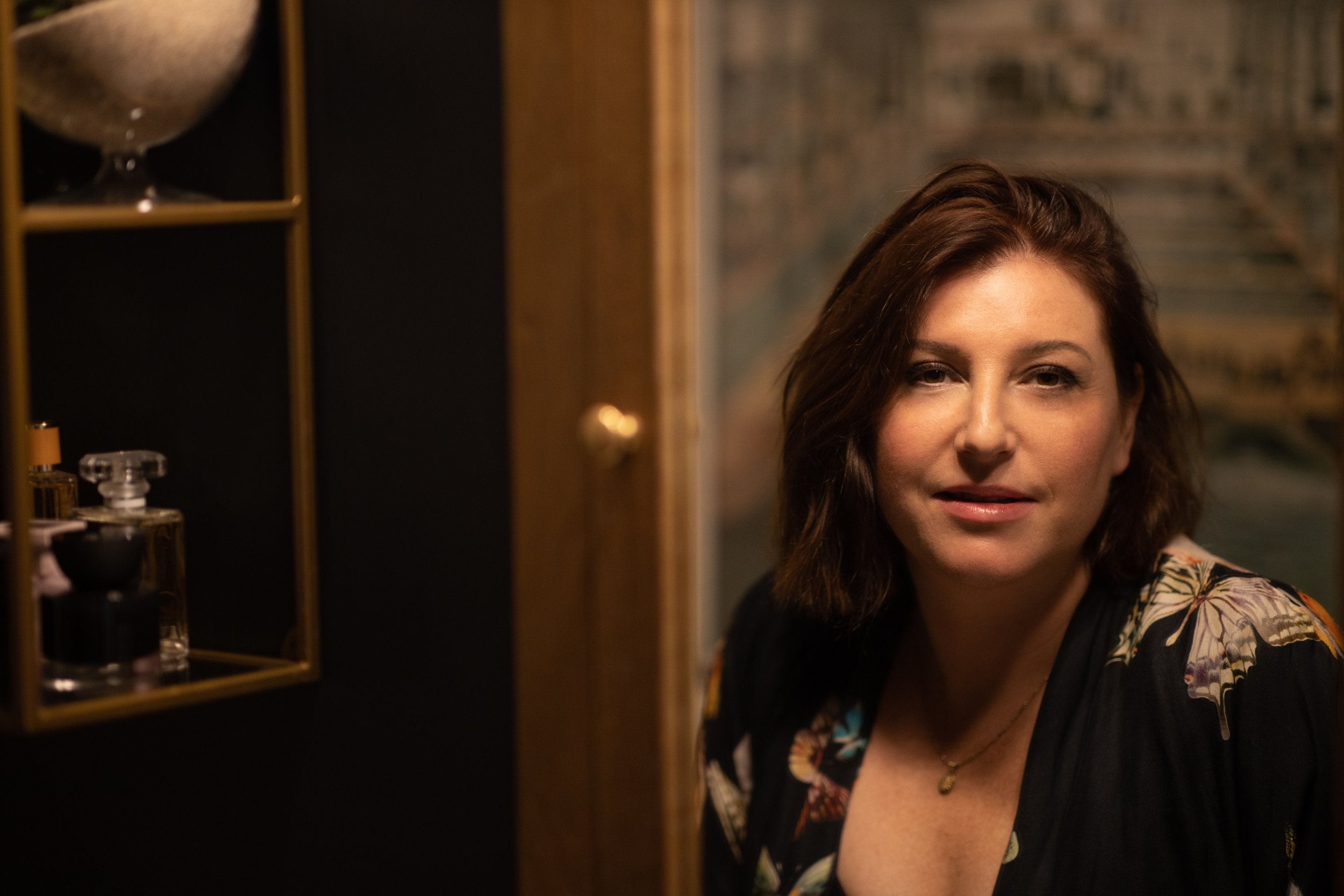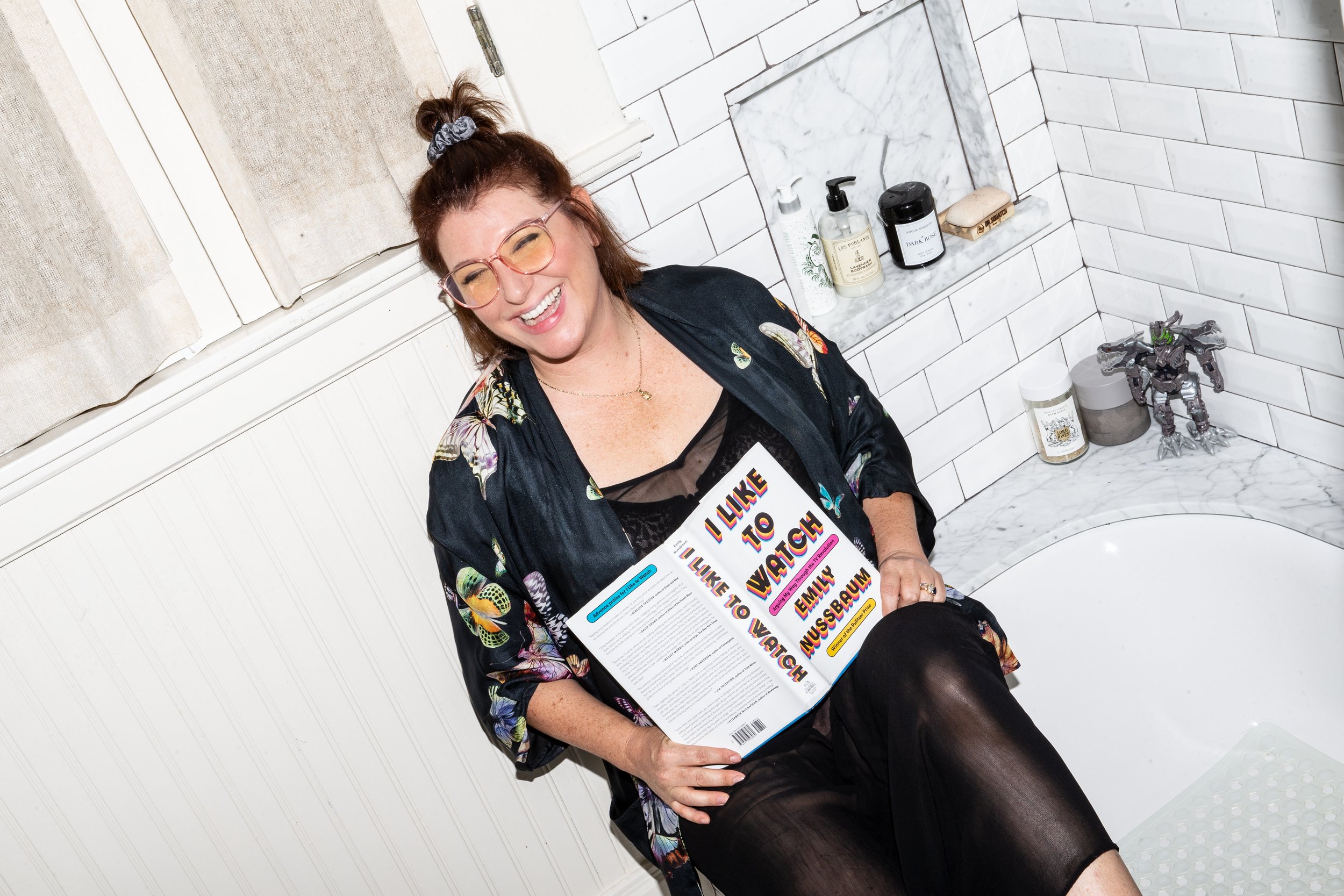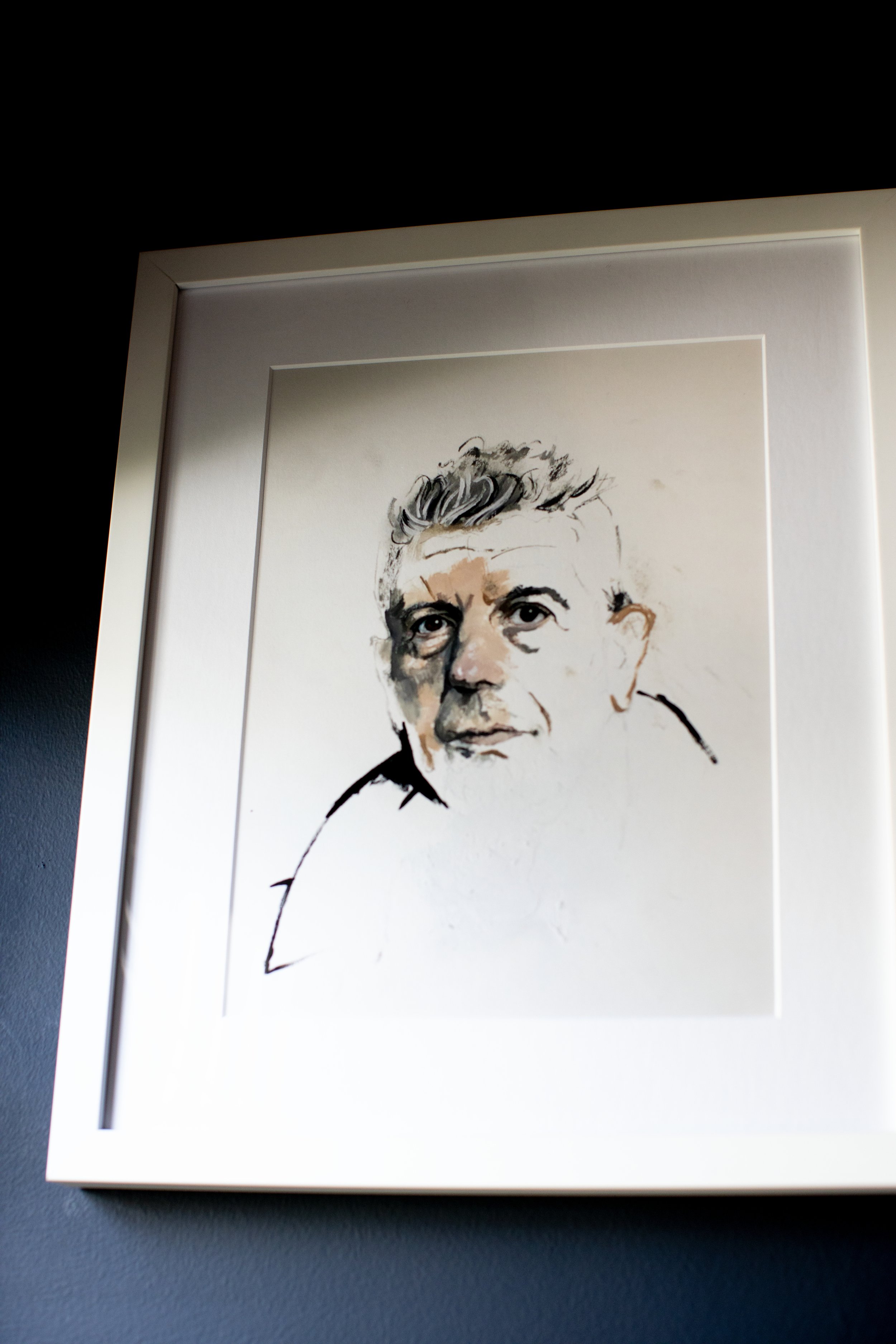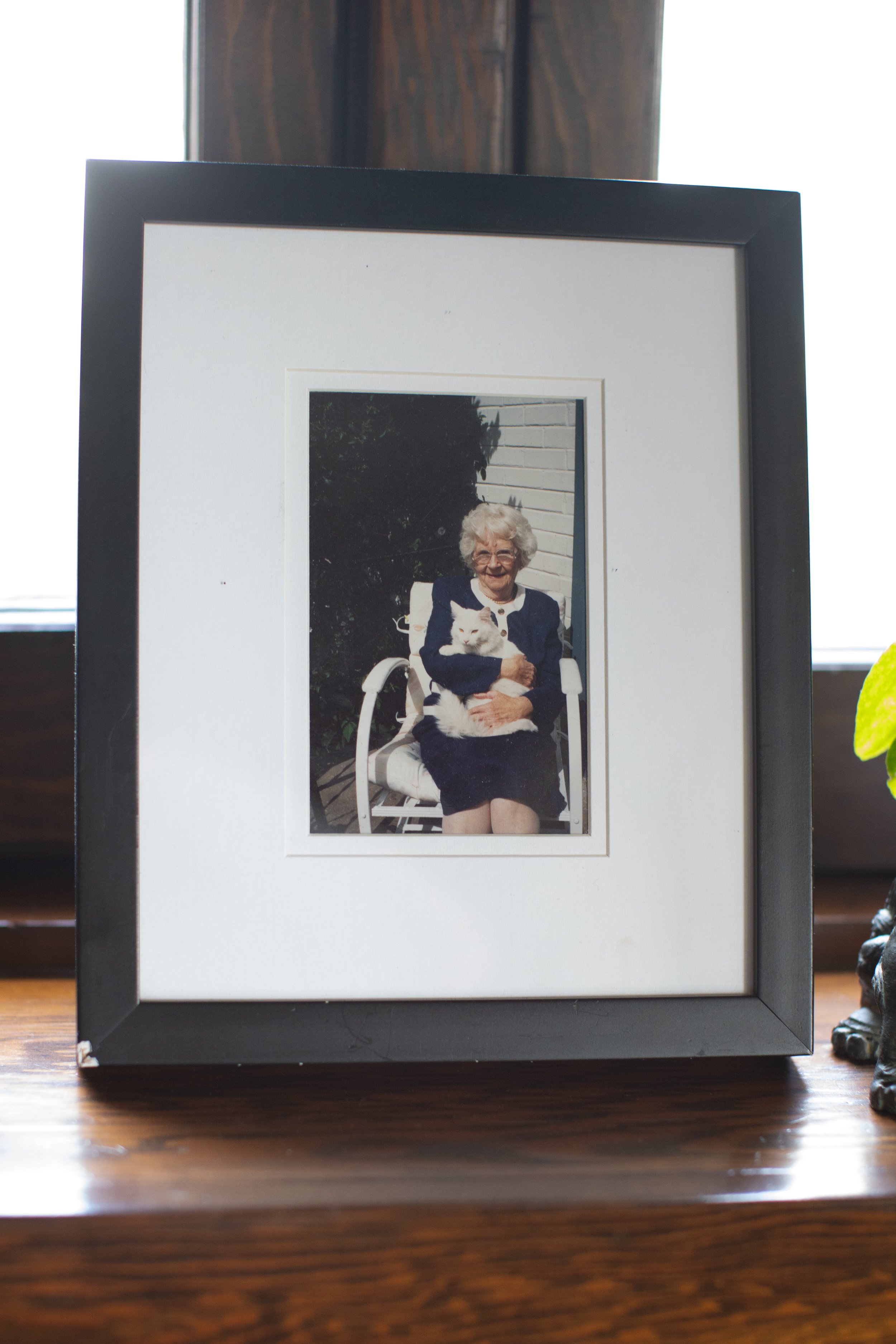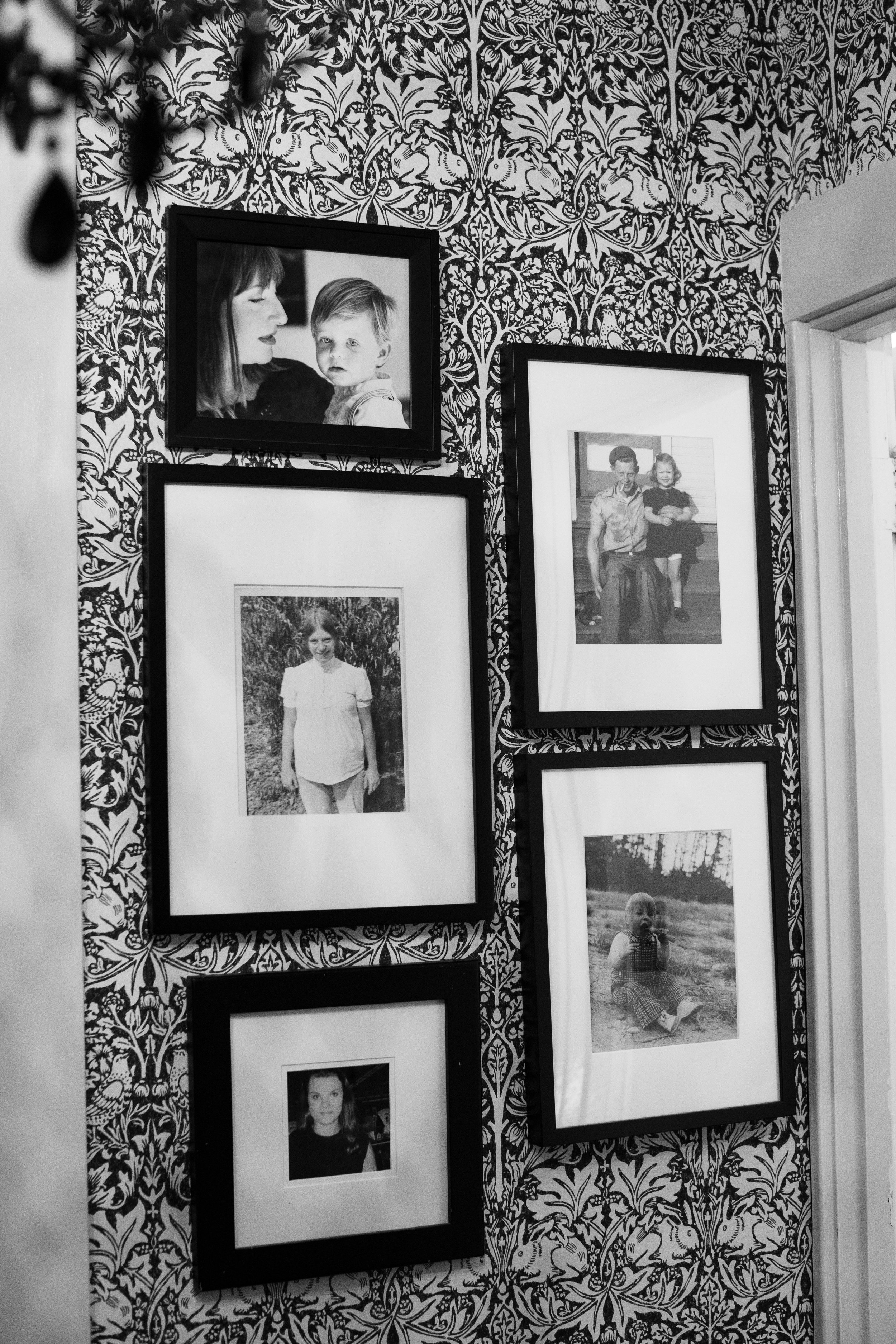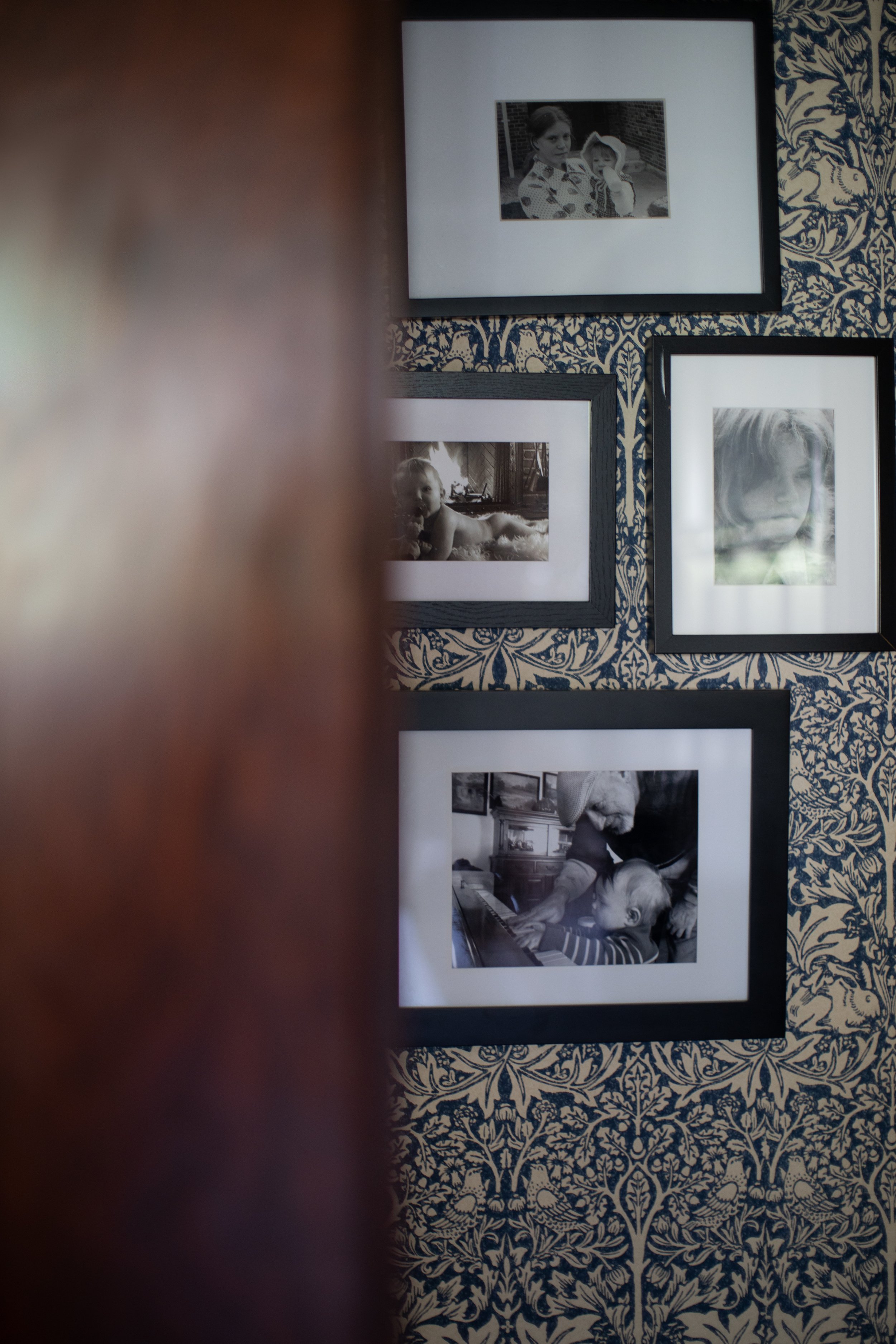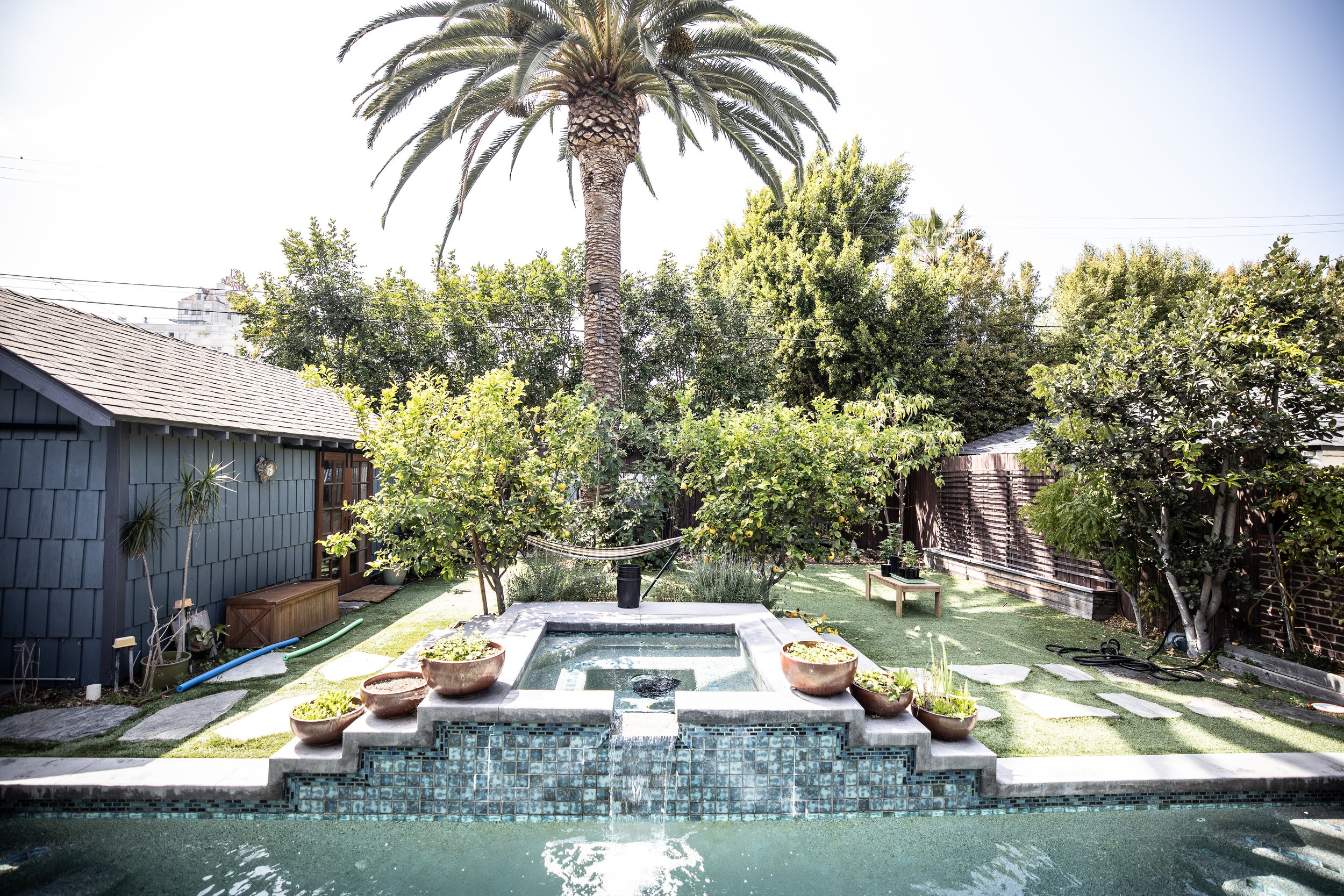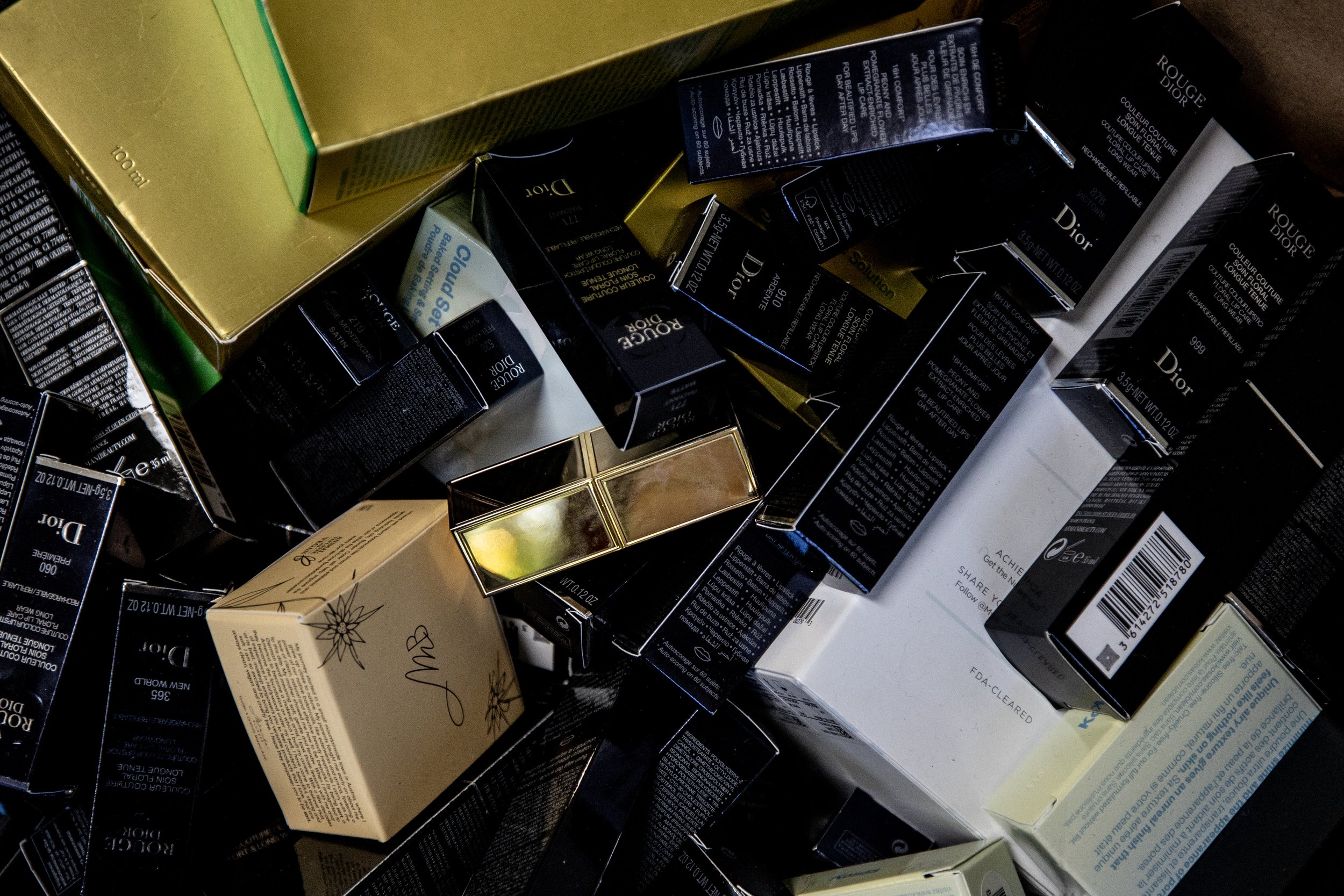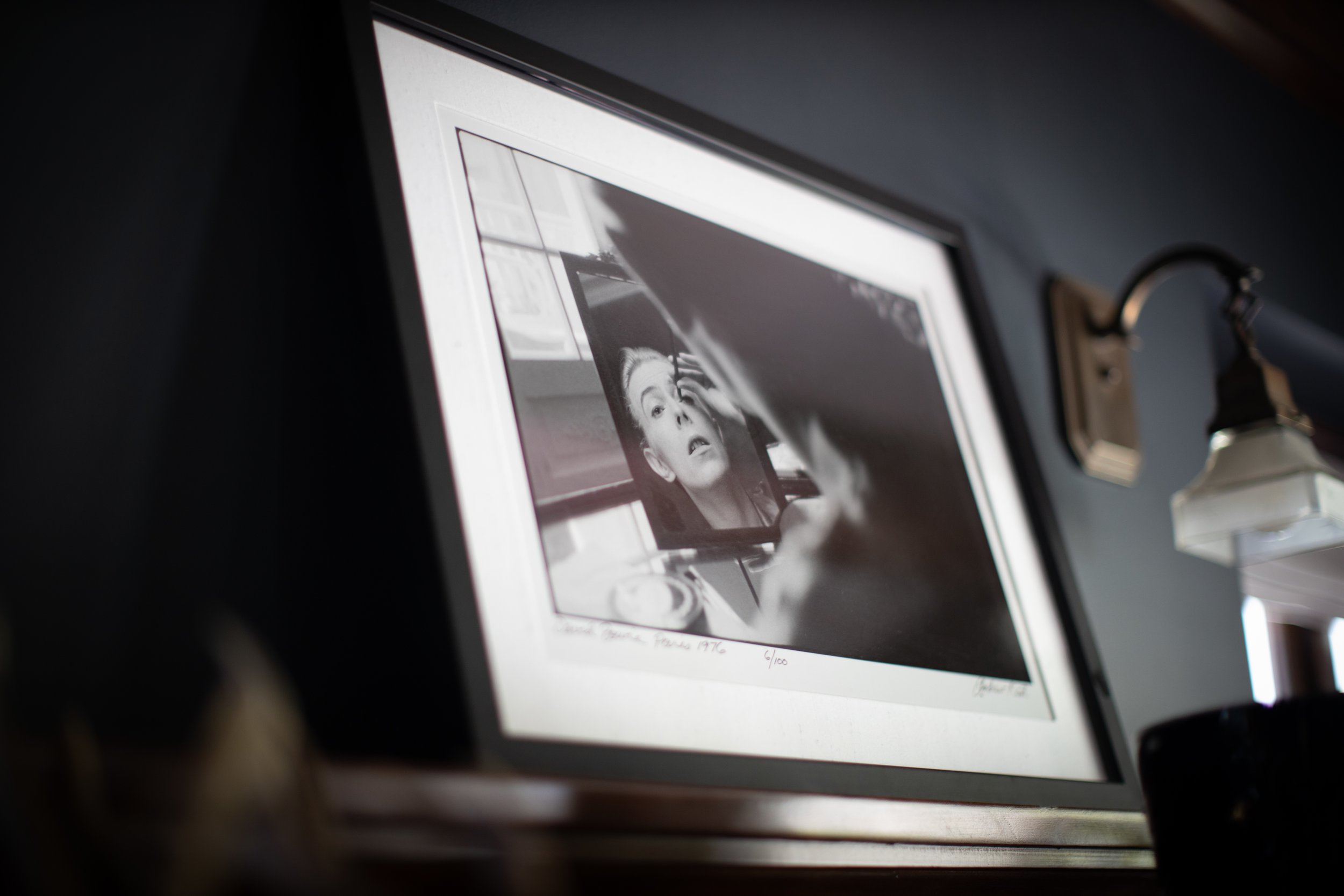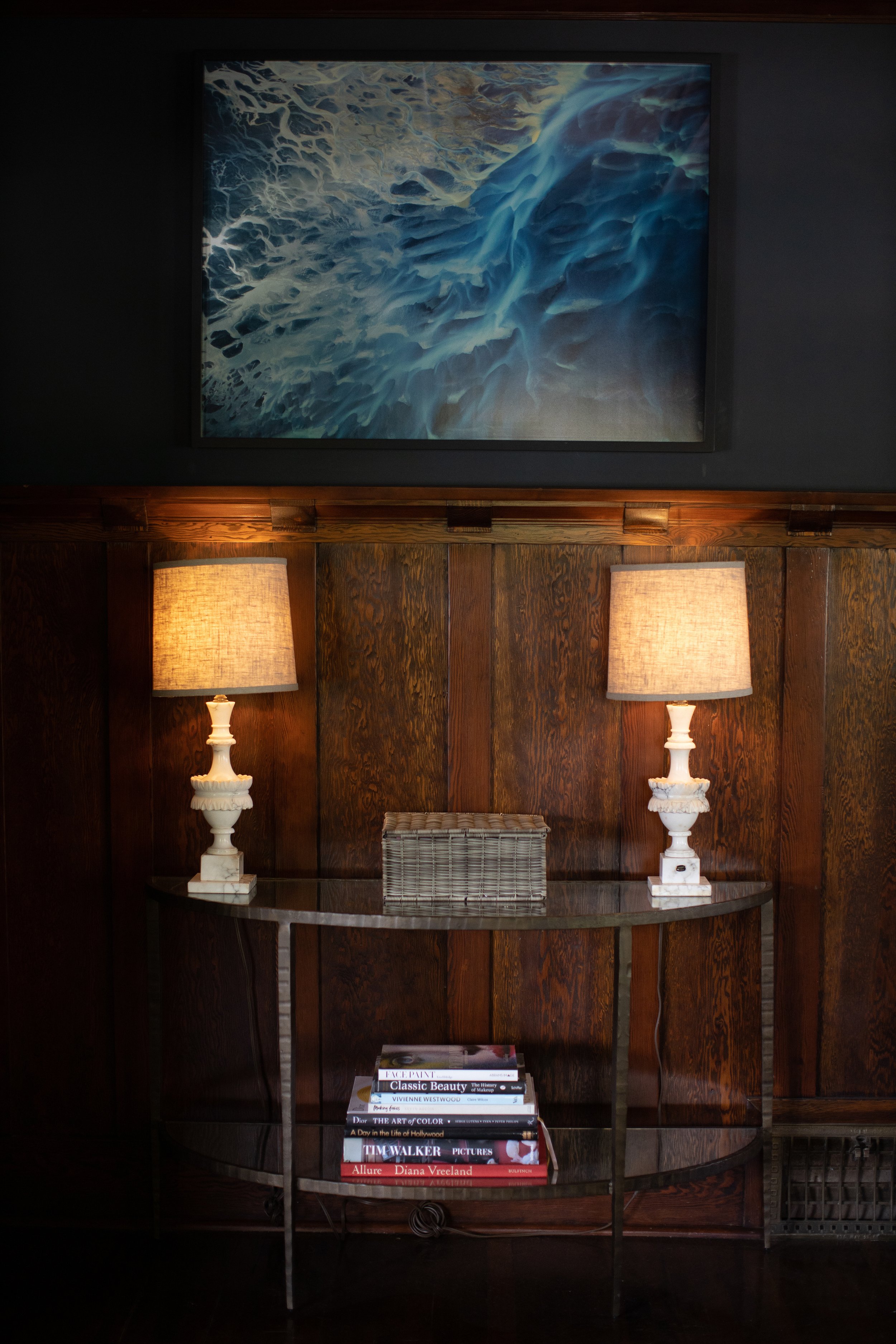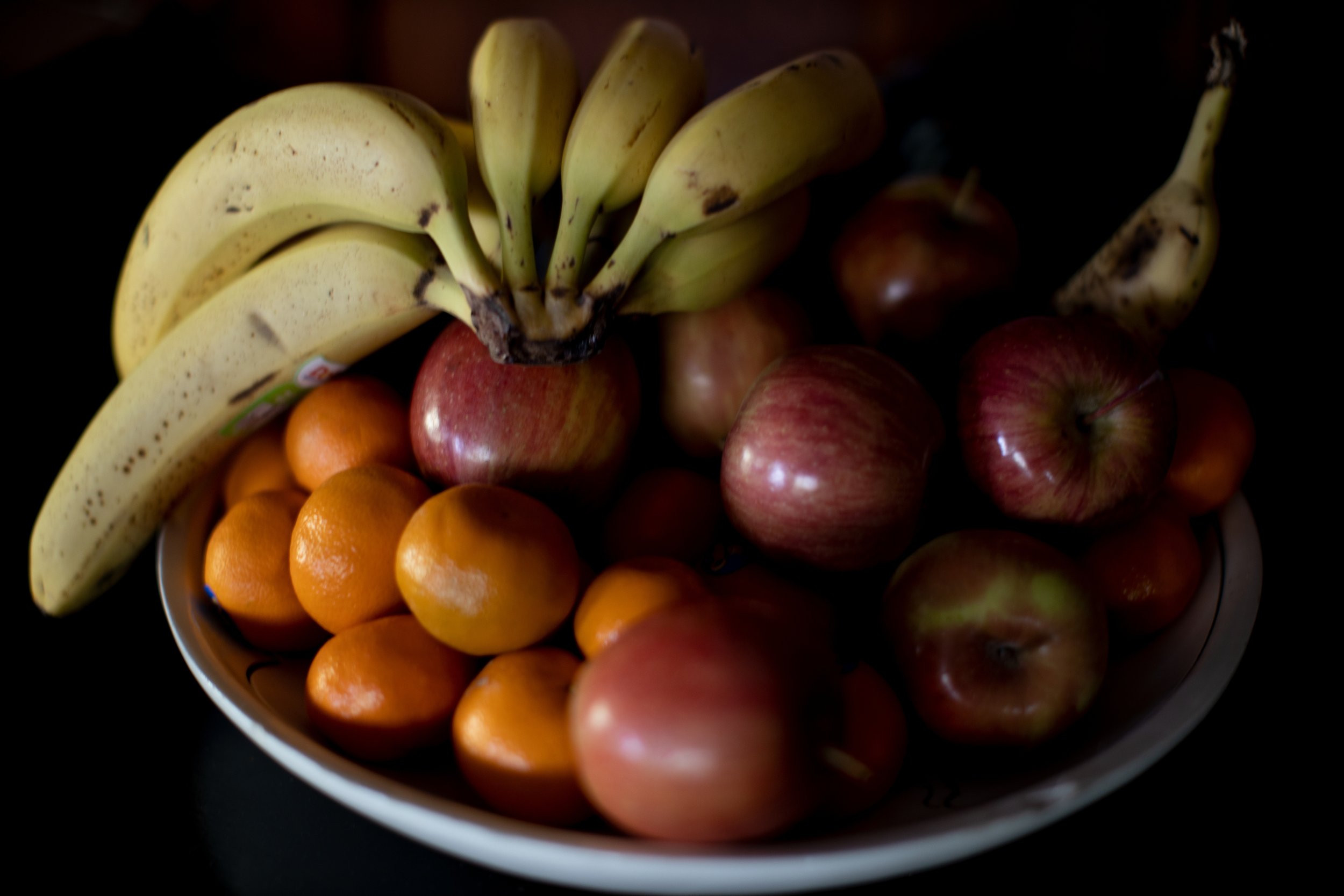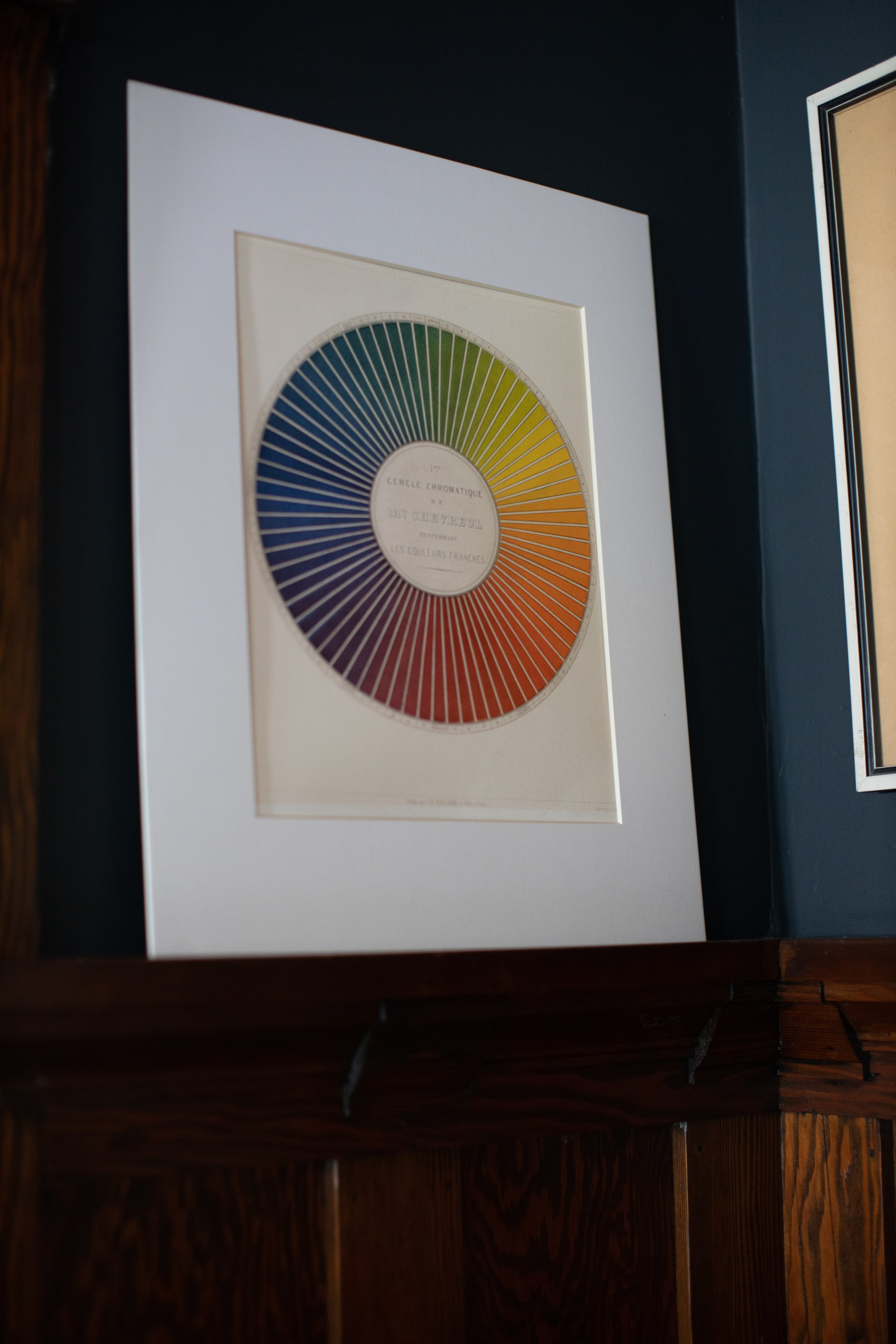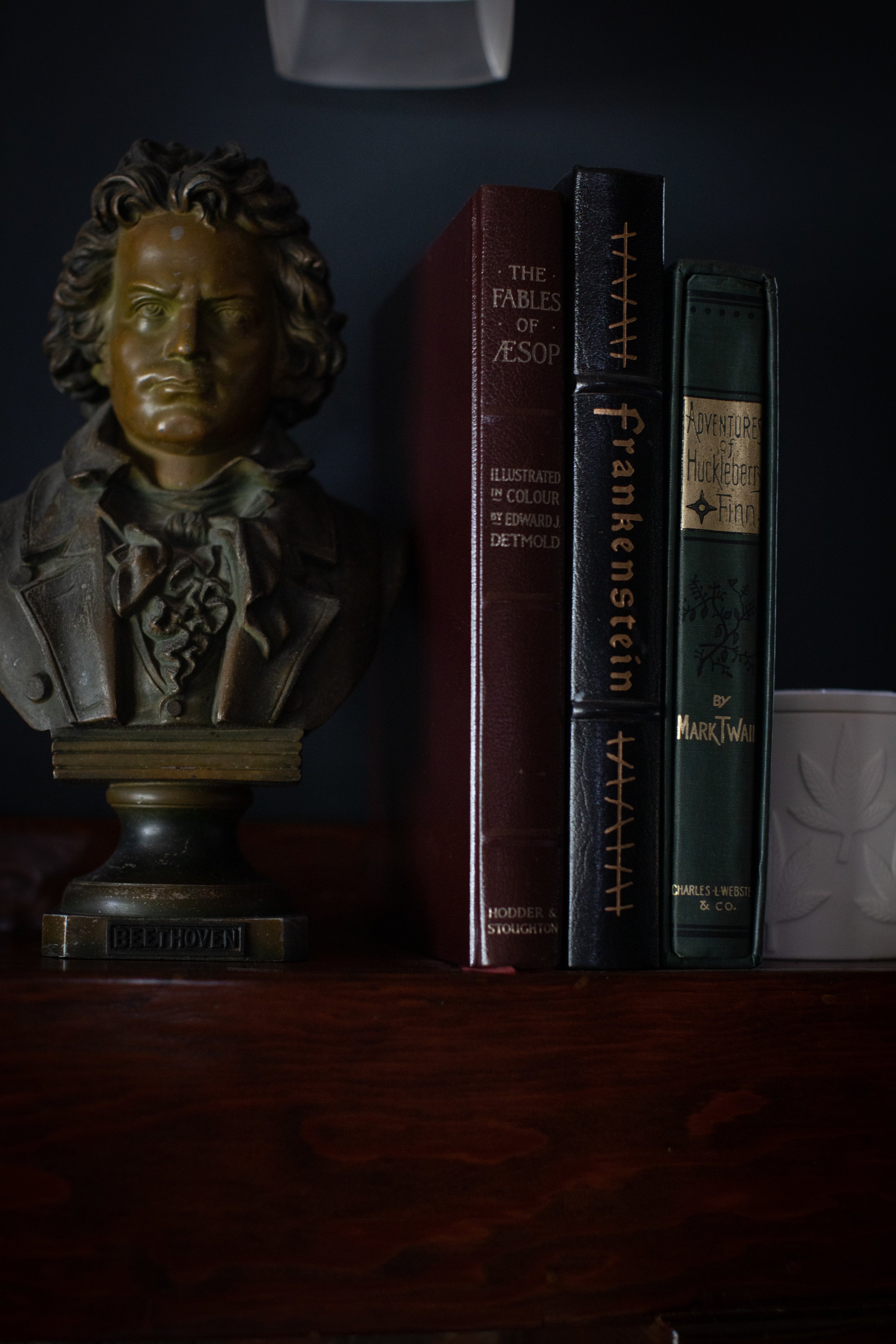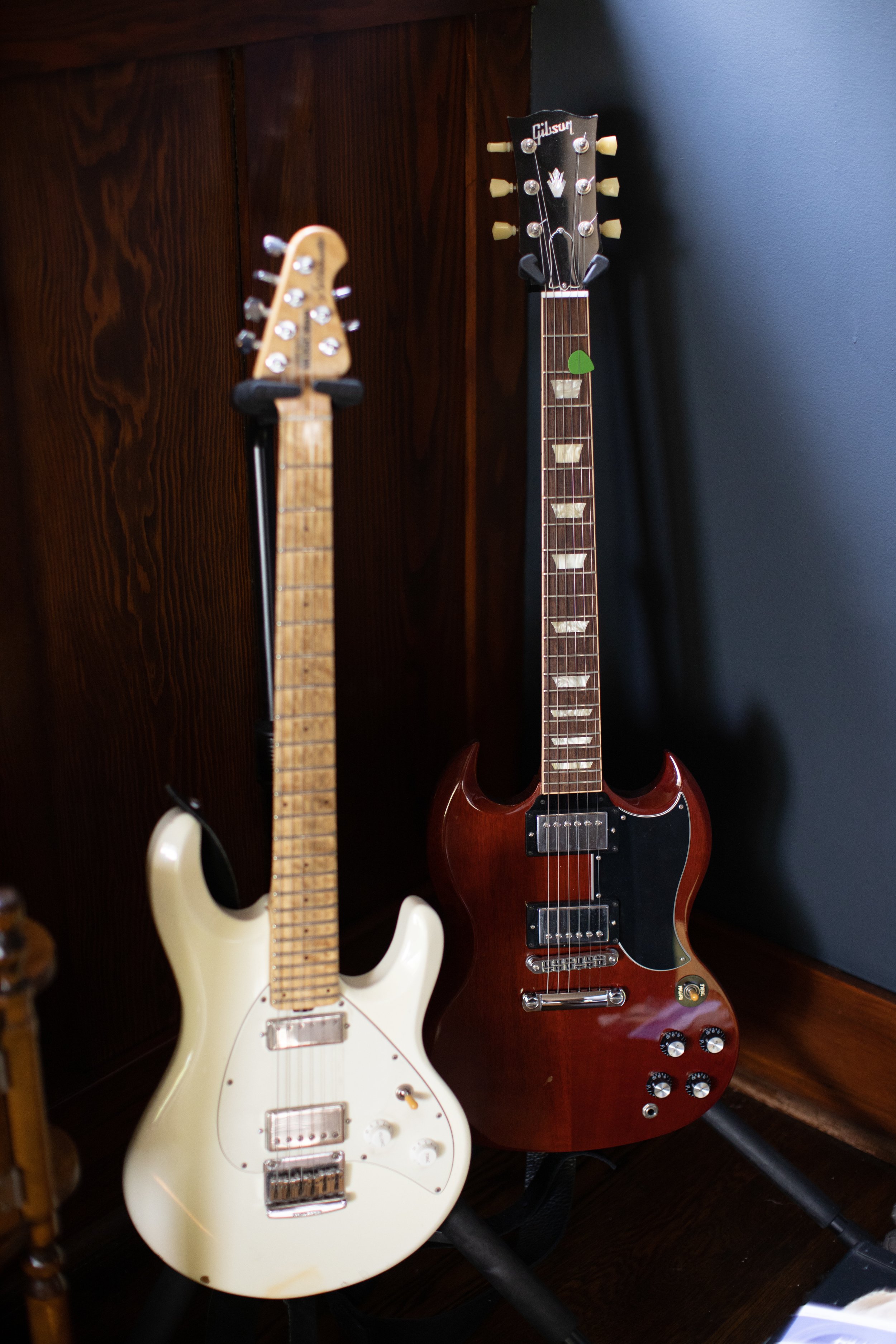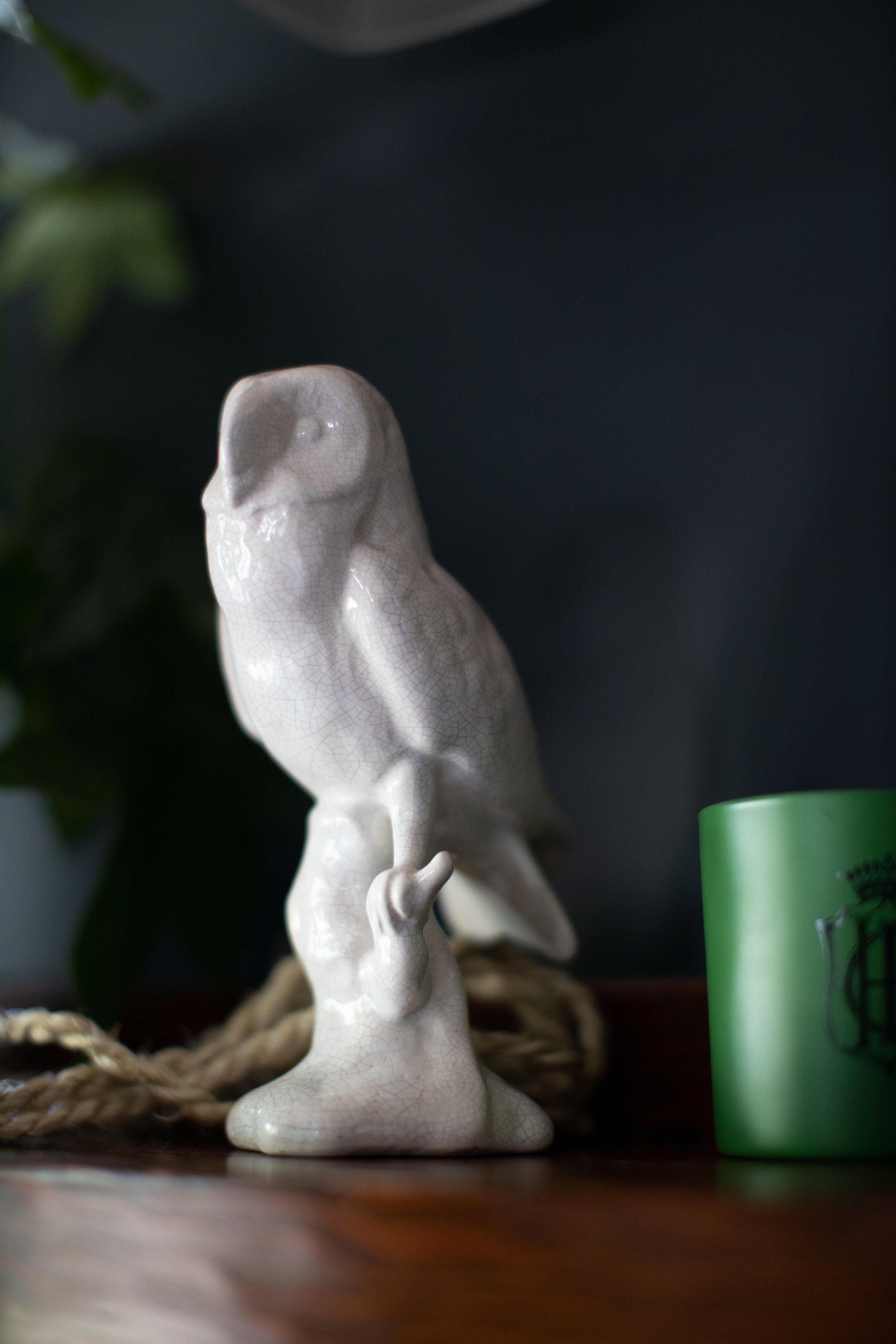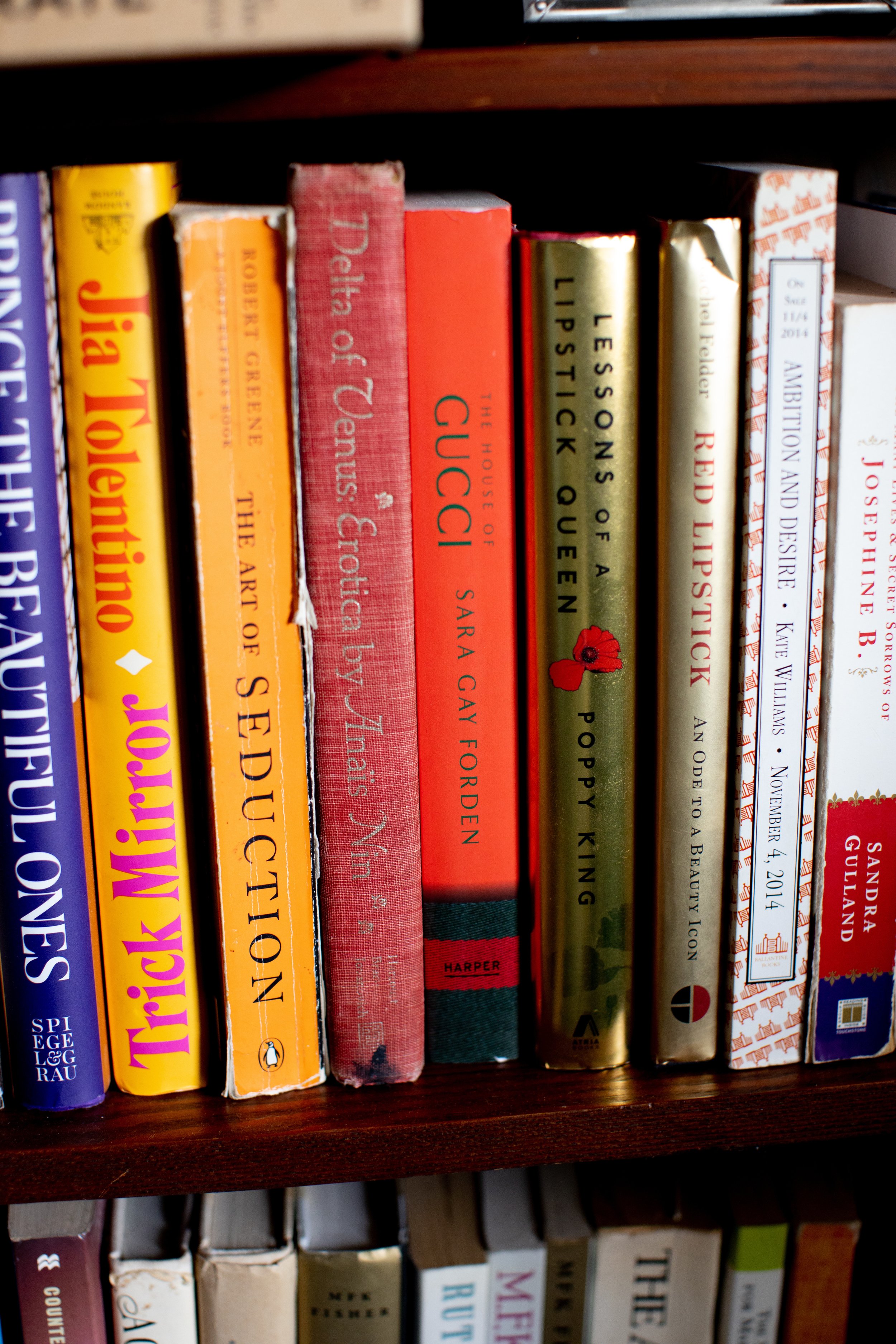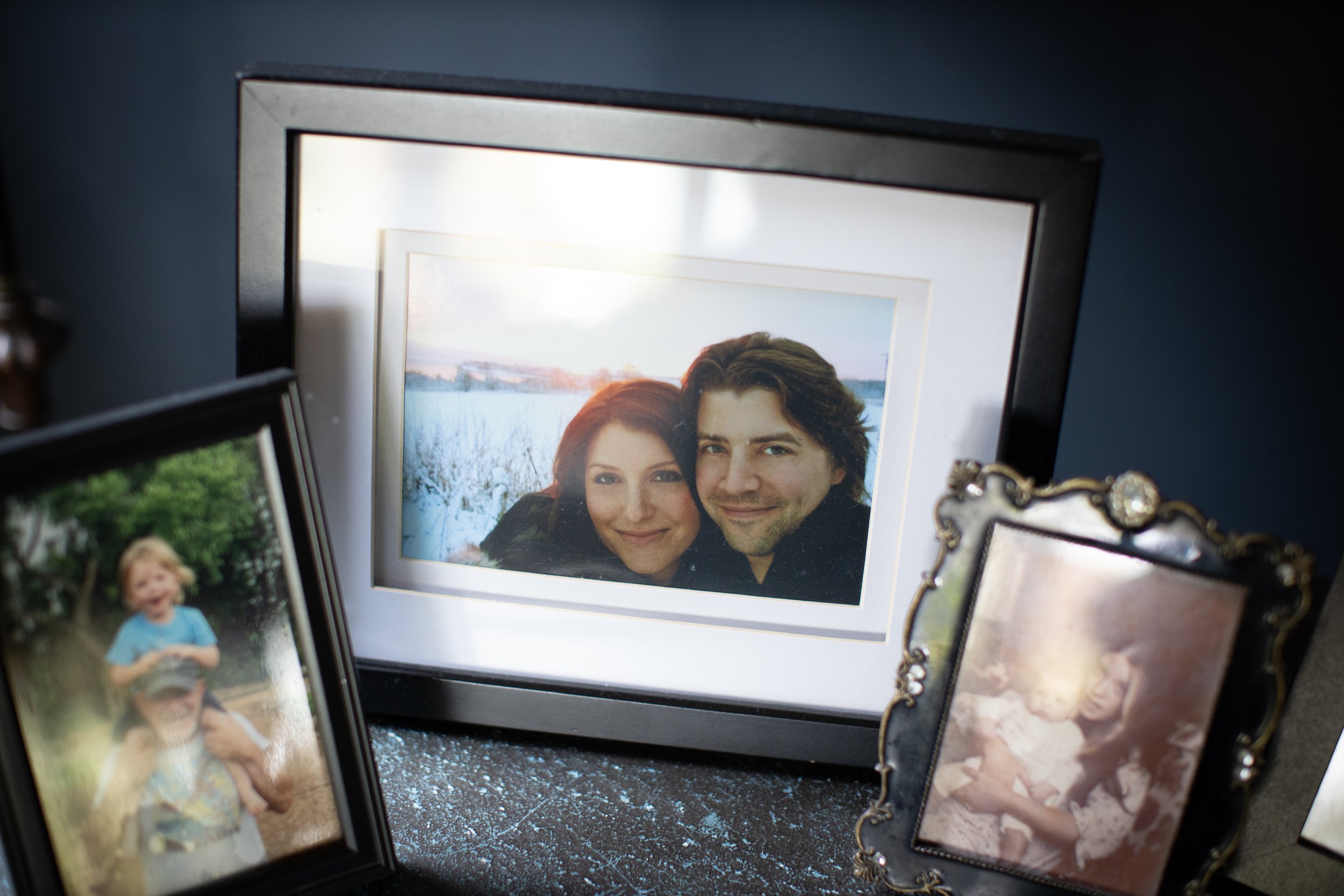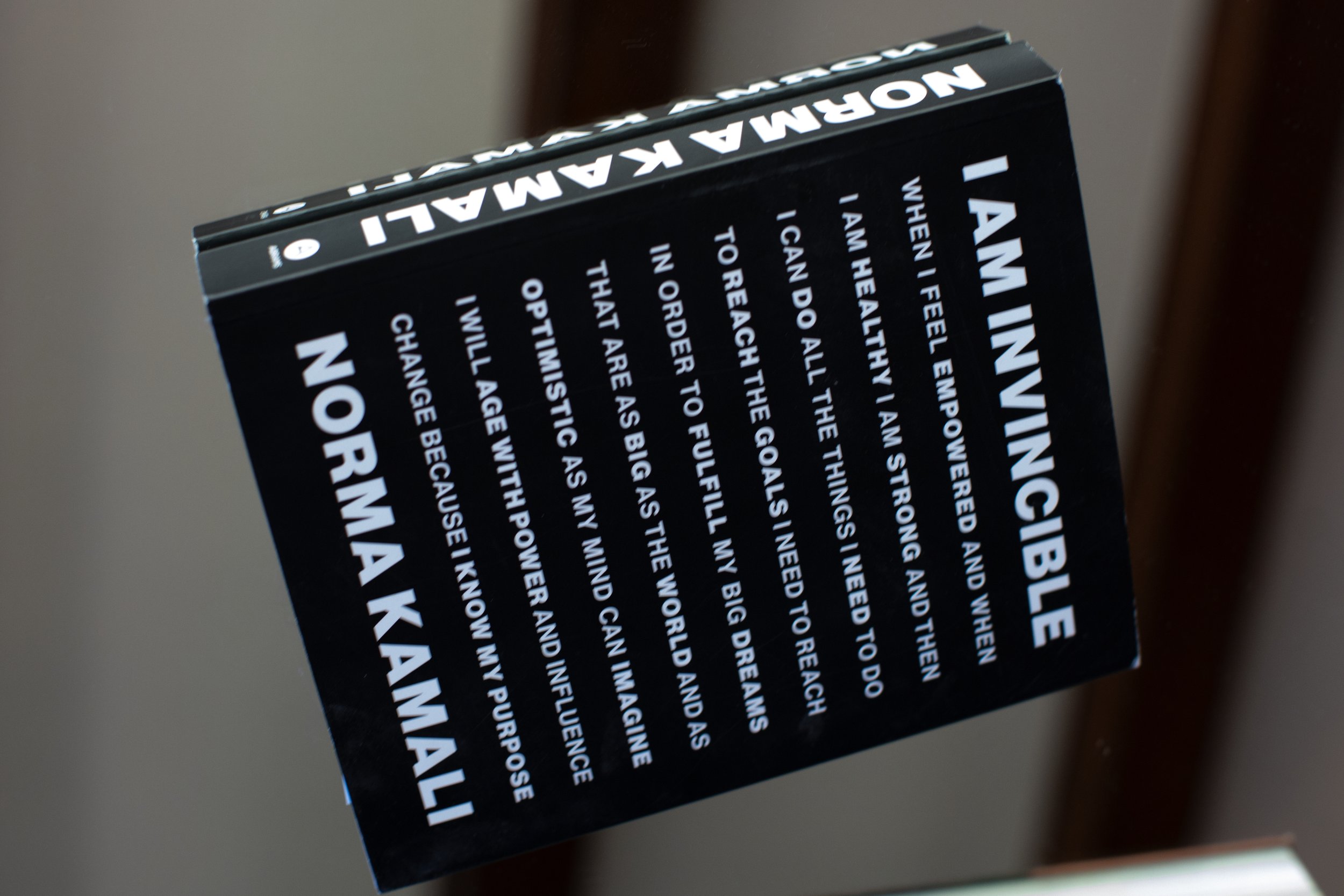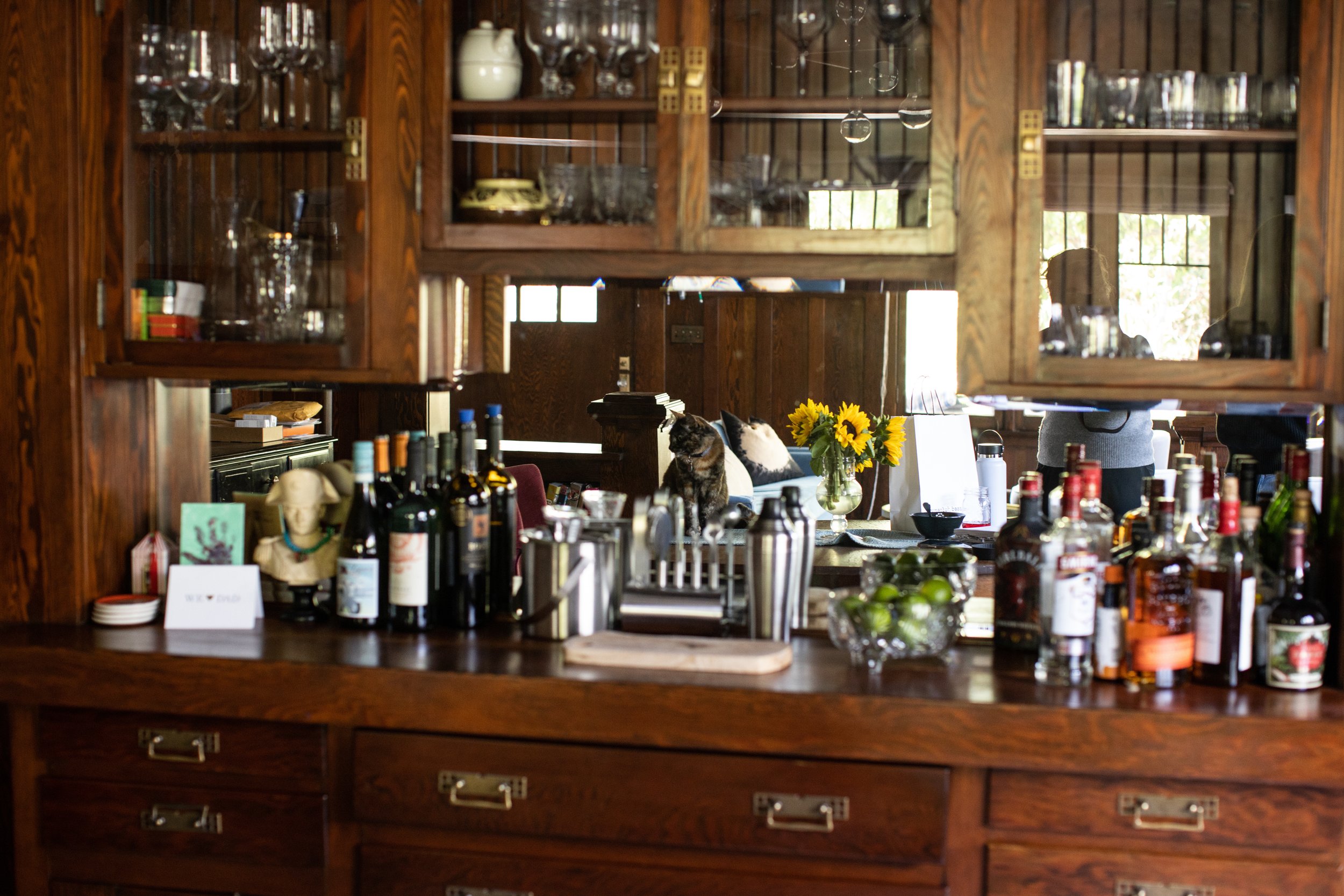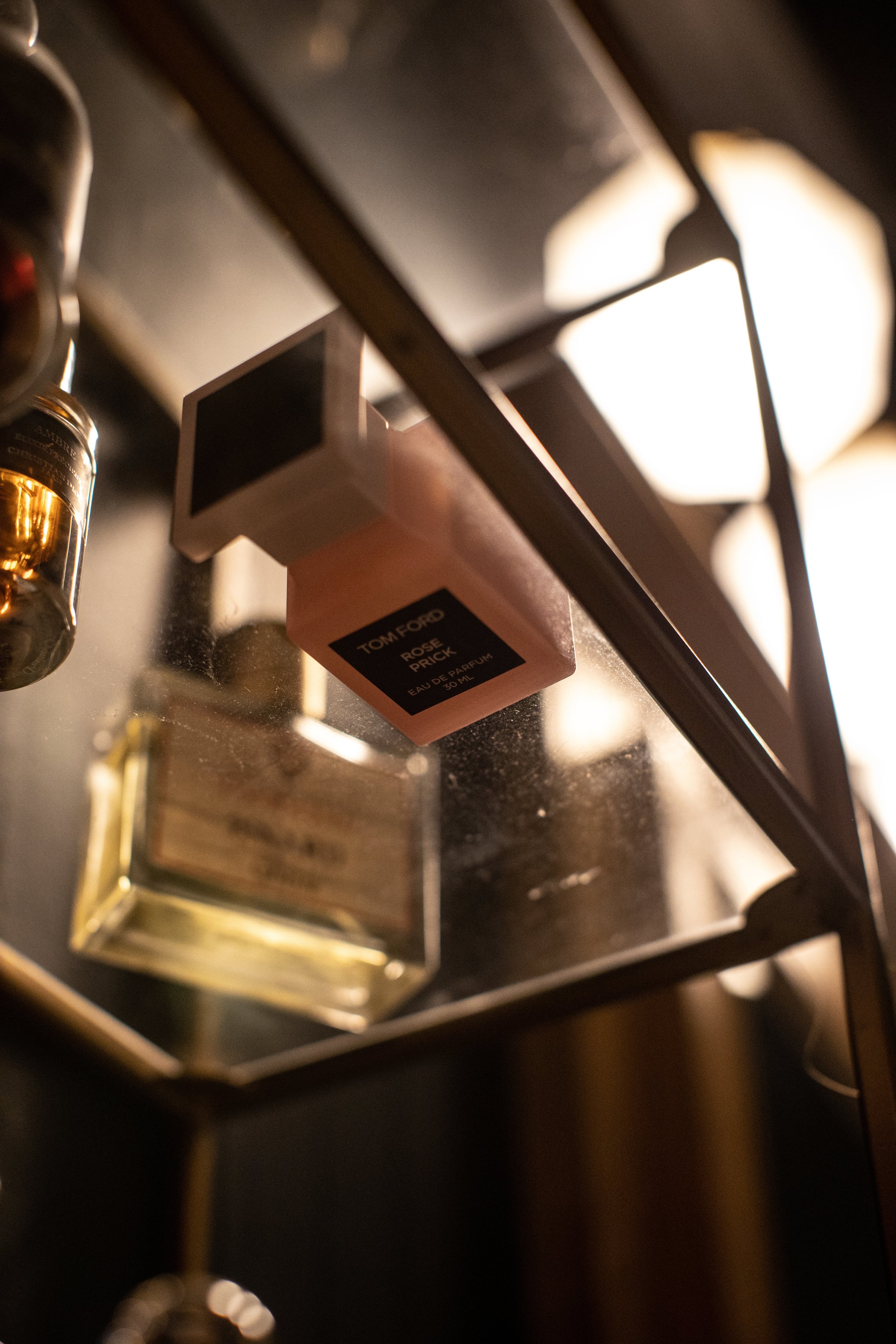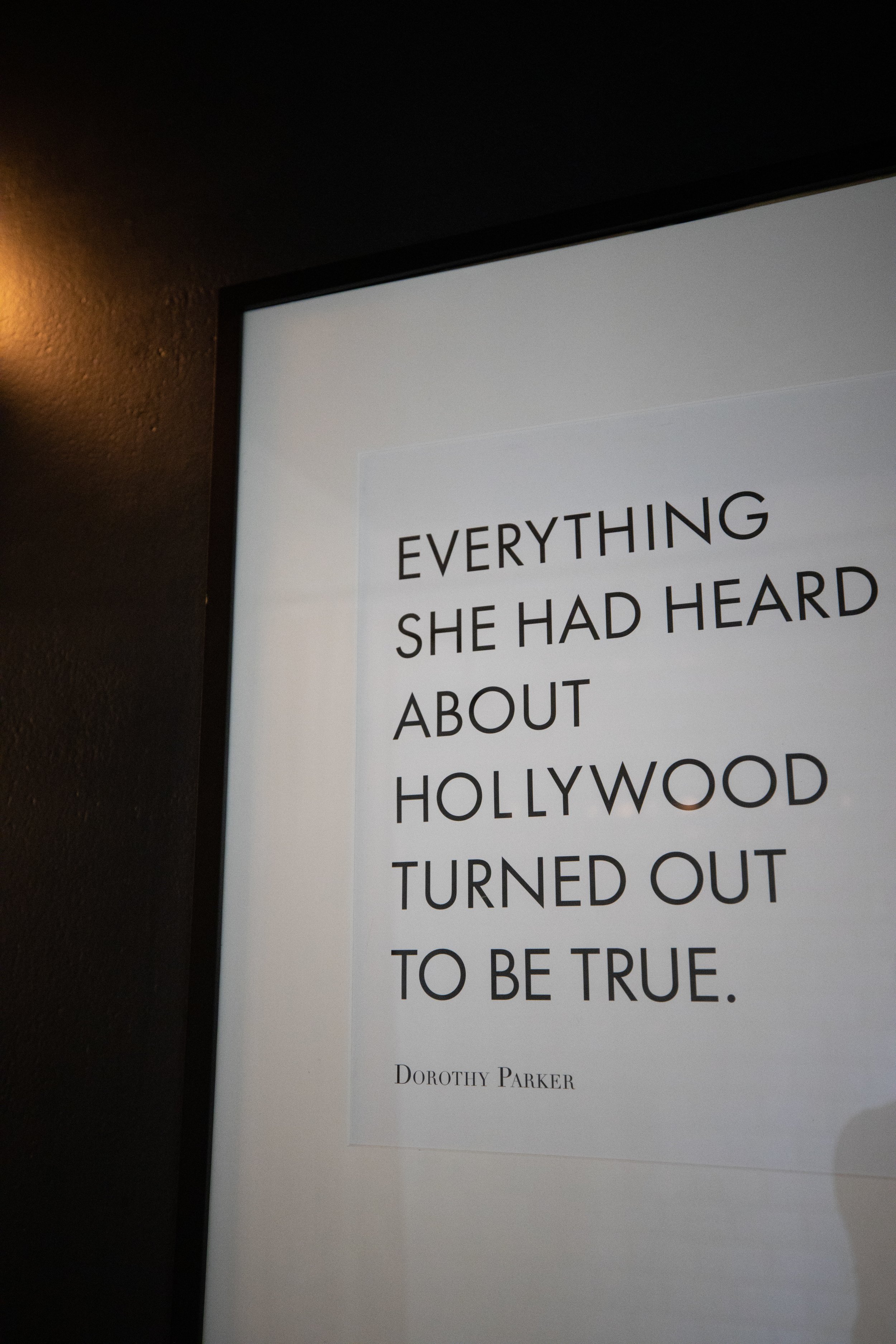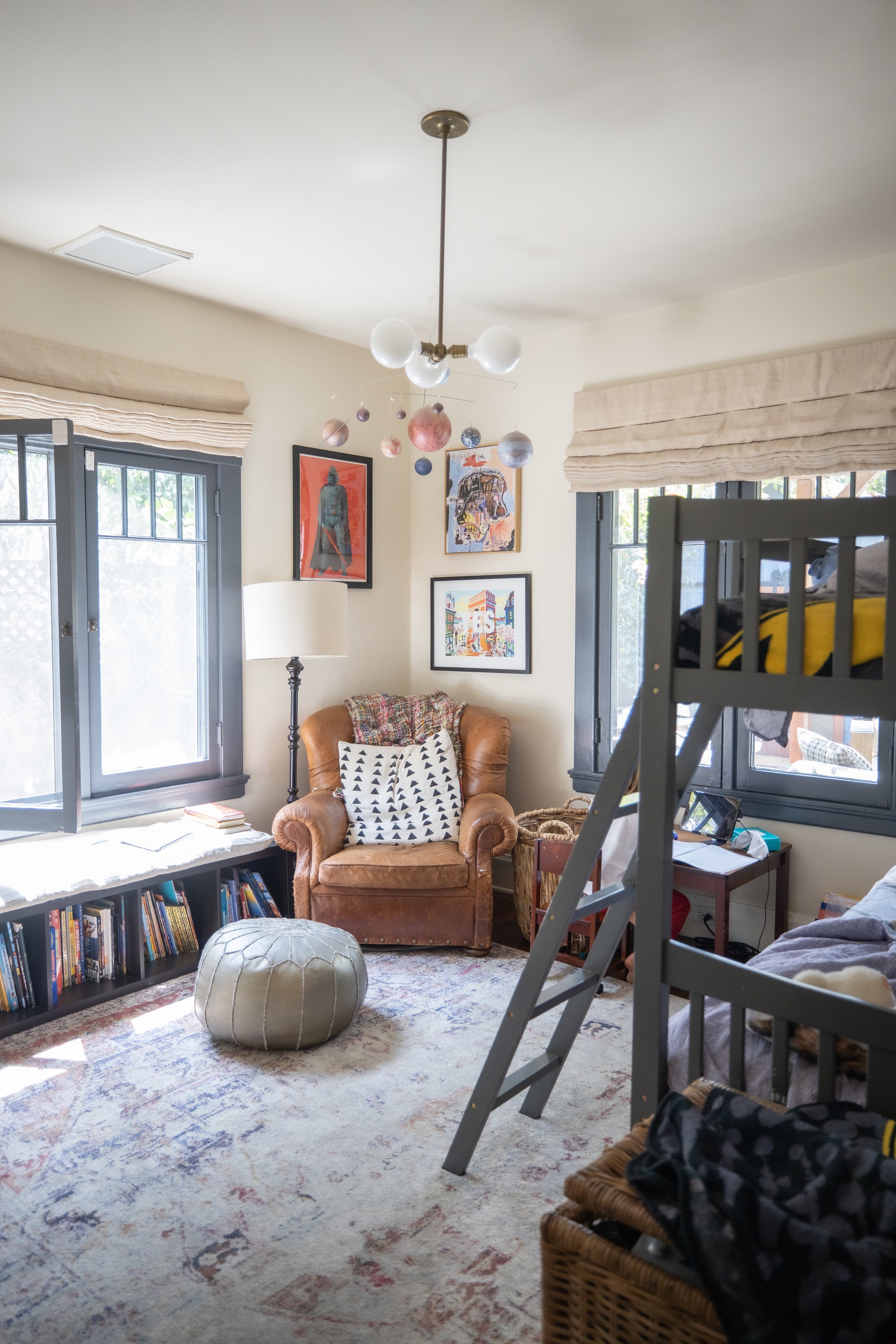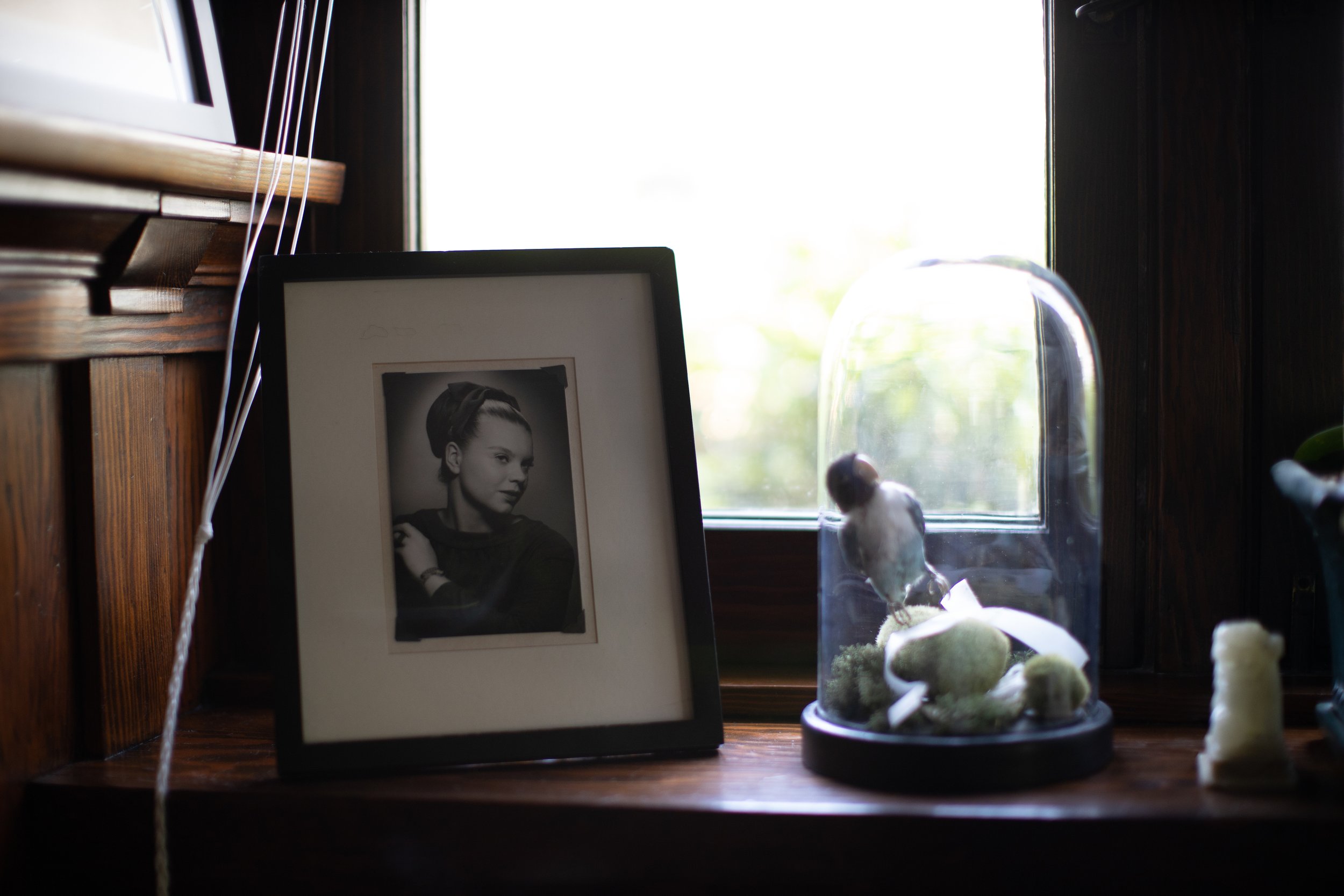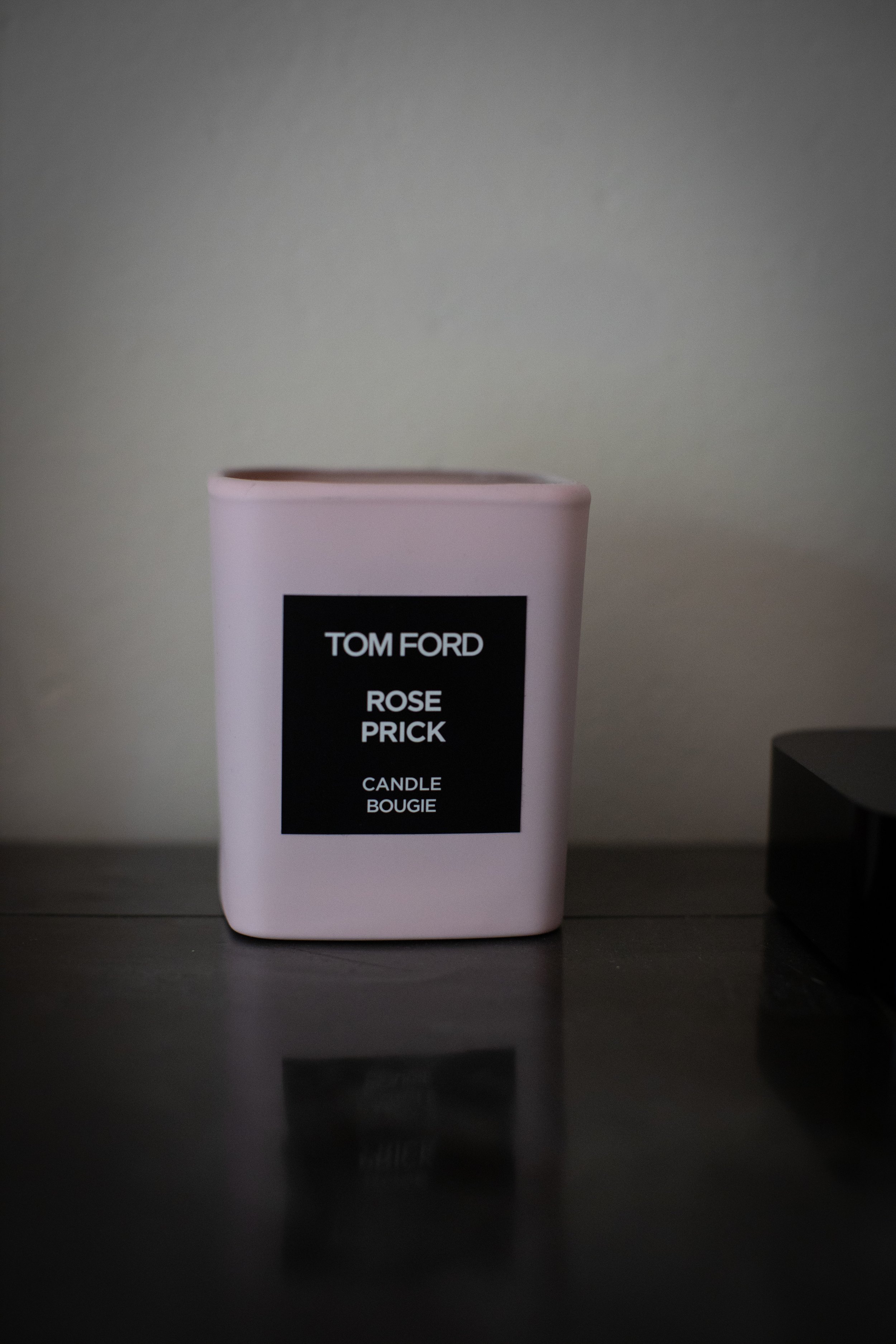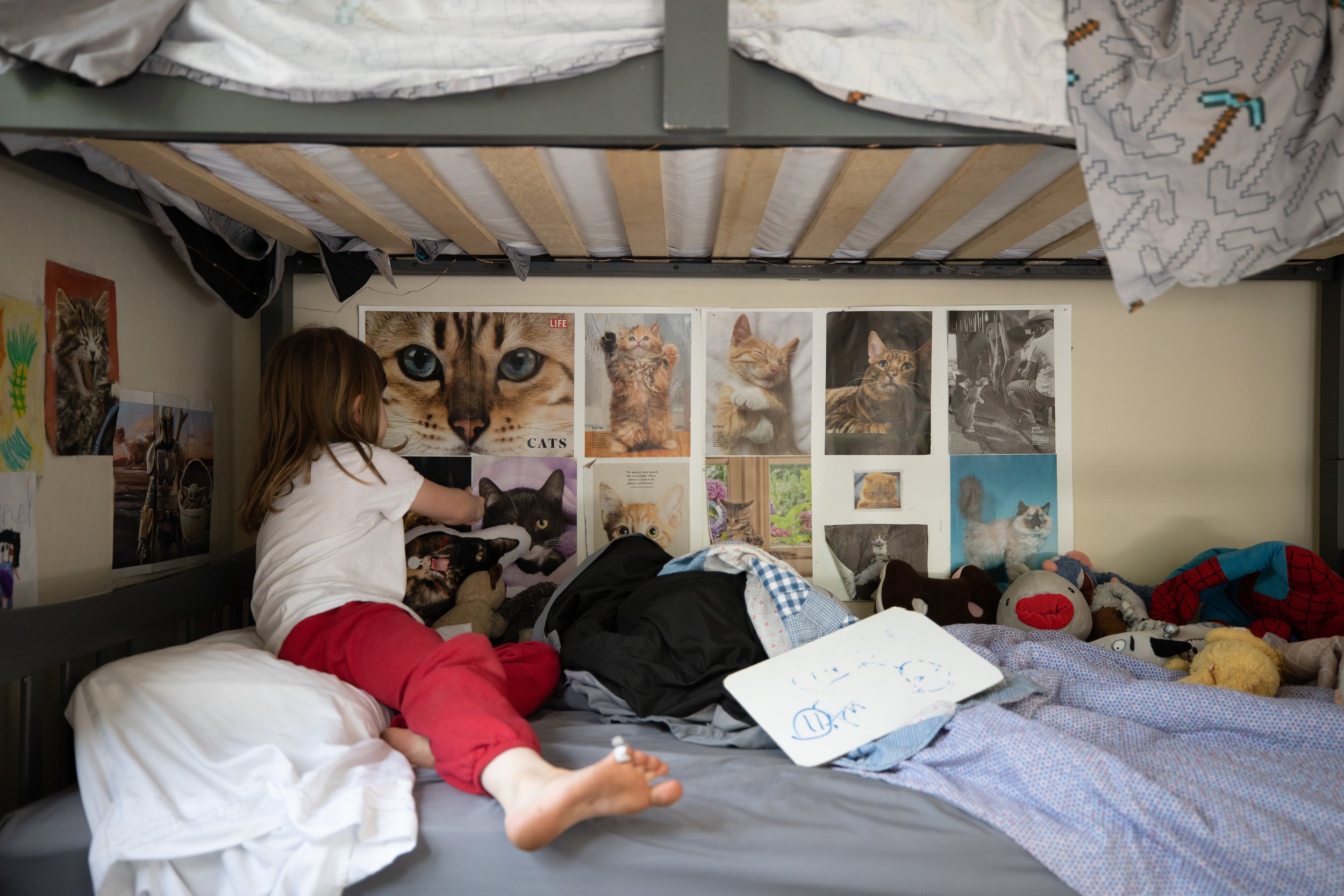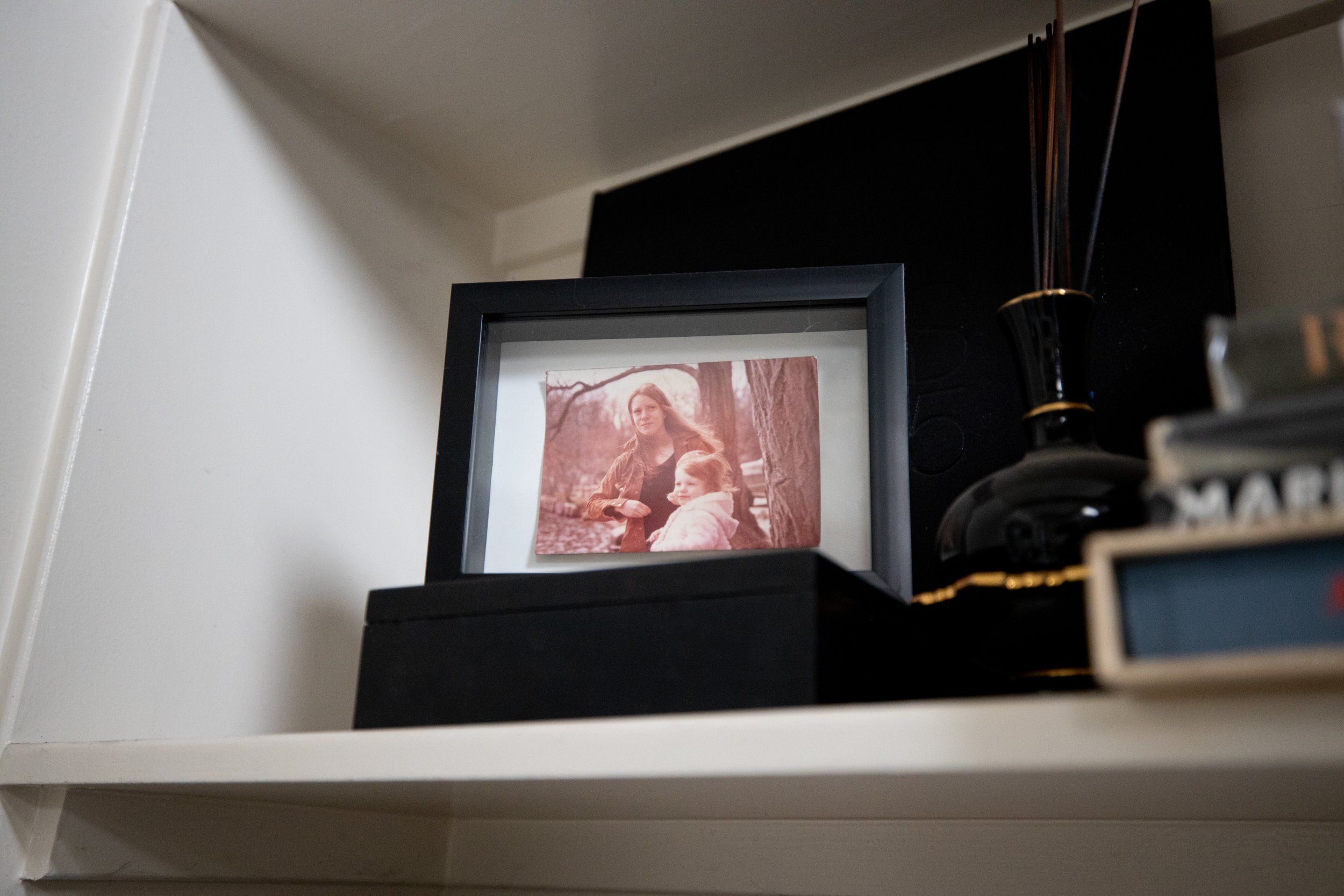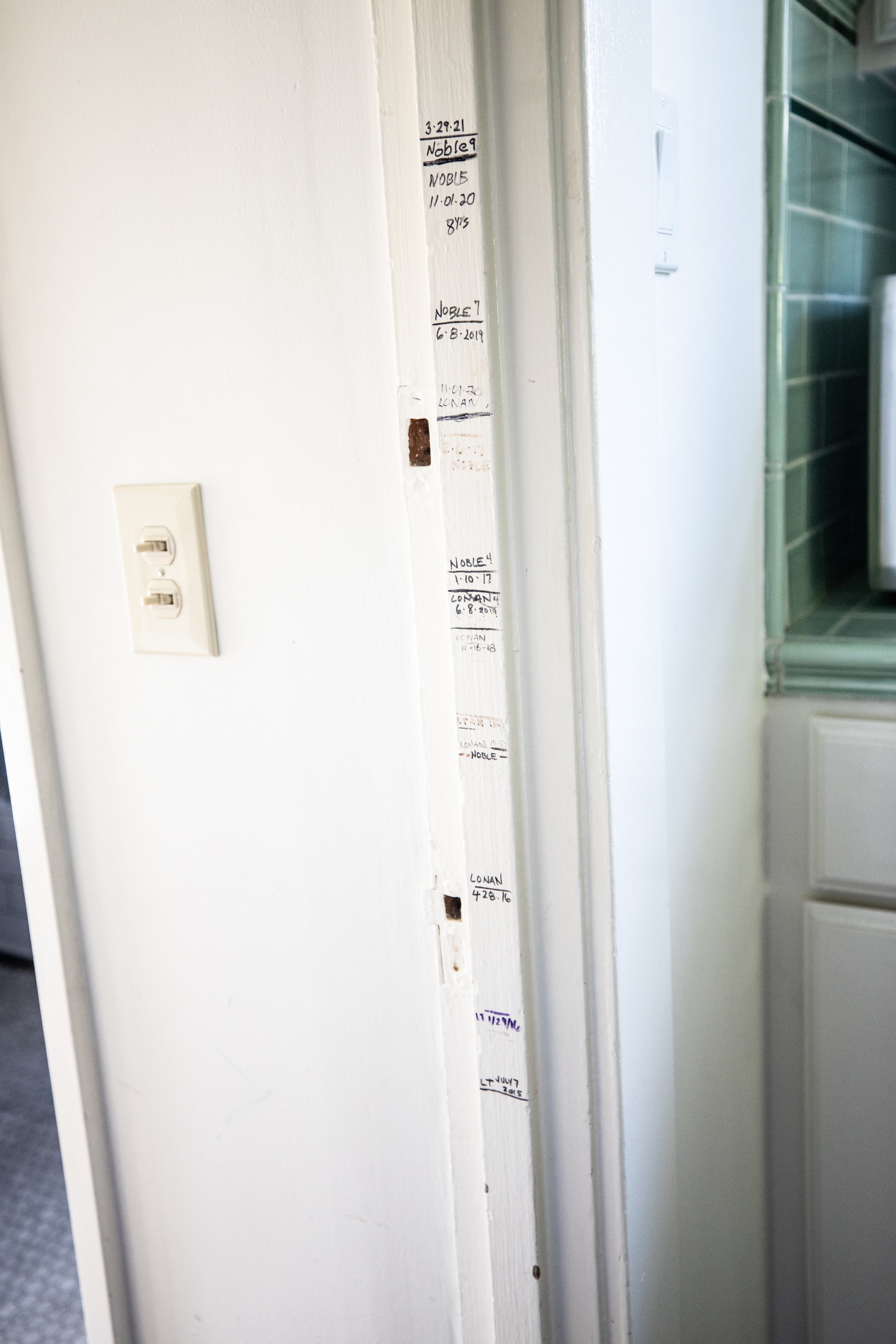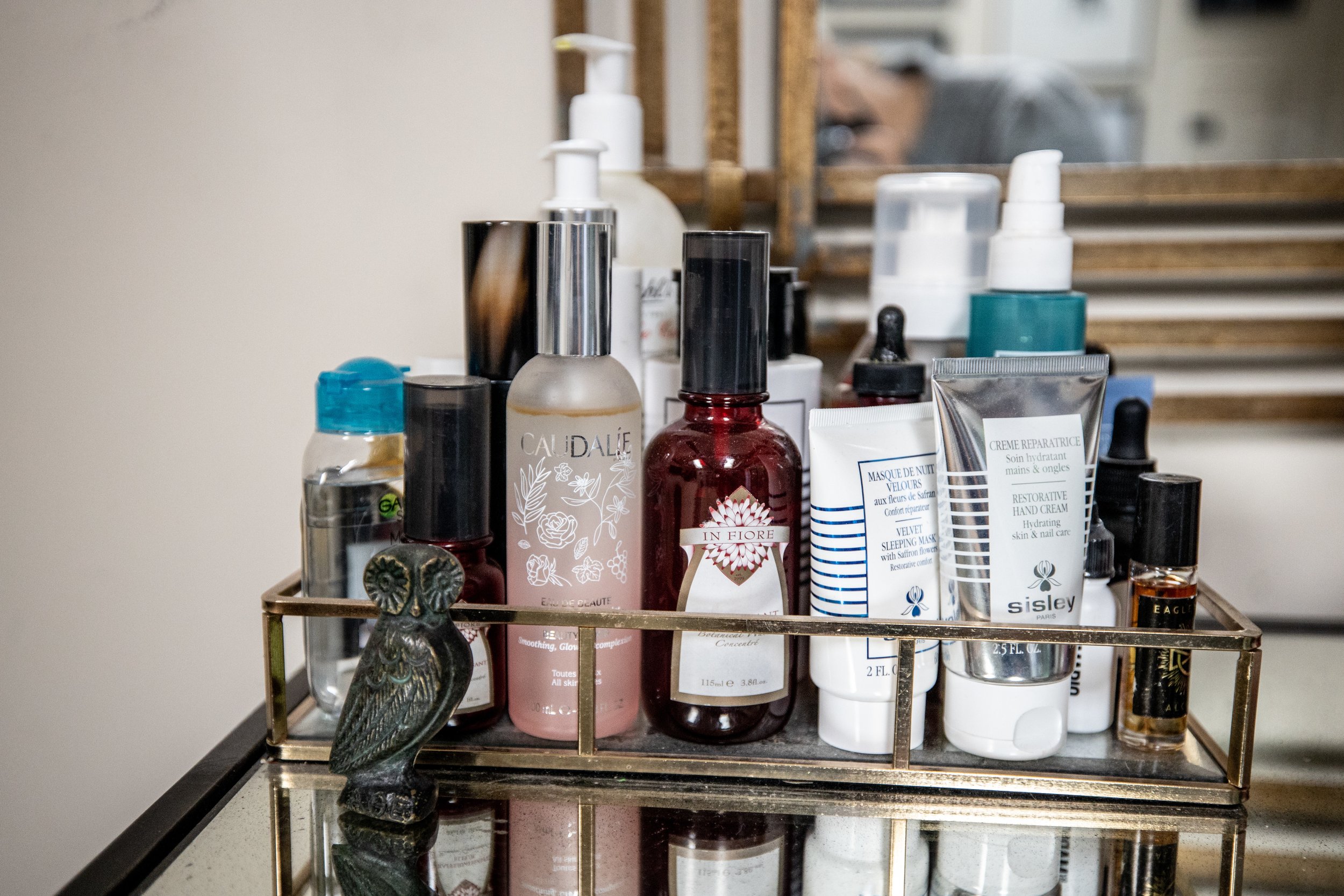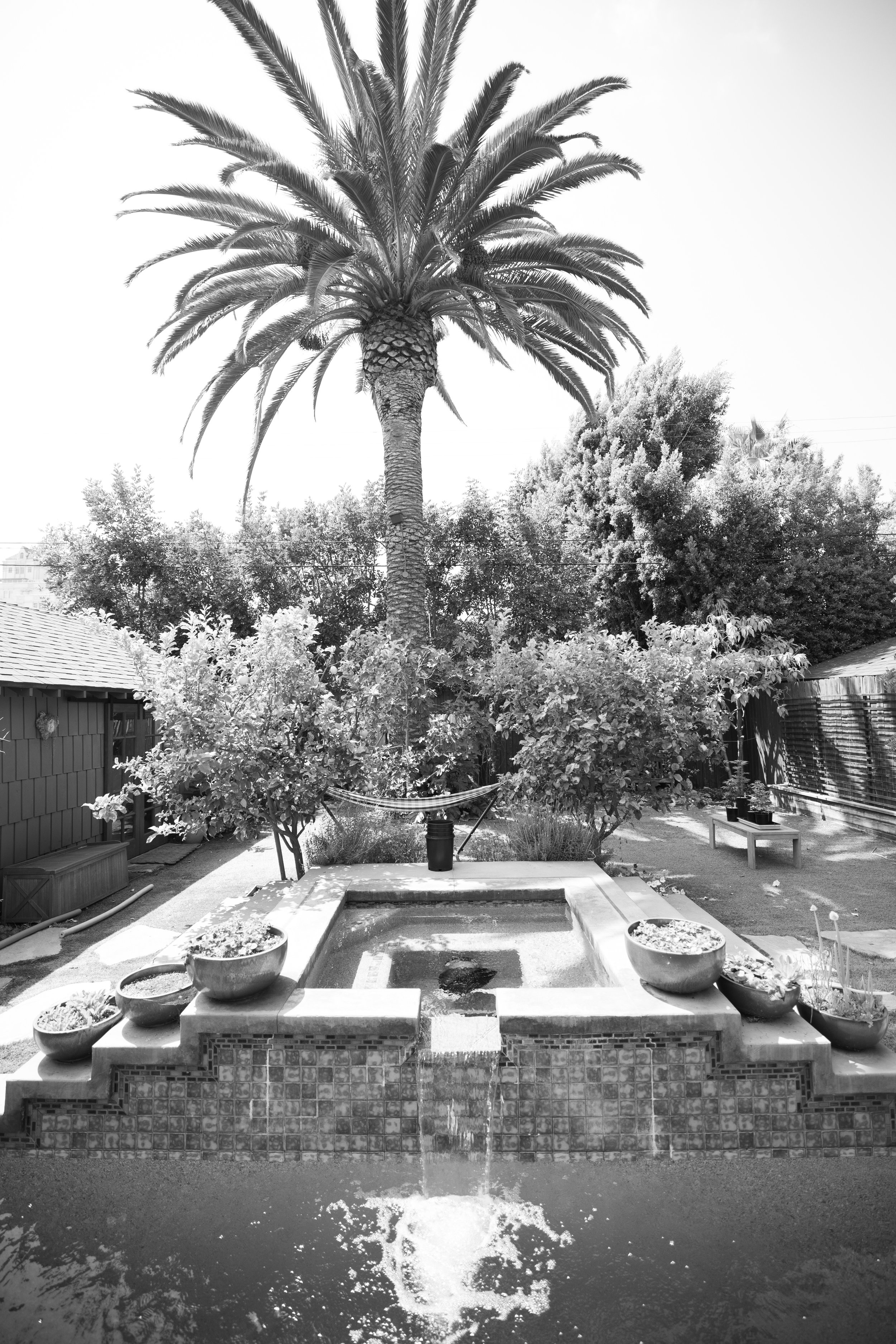Rachel Goodwin
The celebrity make-up artist shares how the world of beauty changed her life and helped her heal.
By Lindzi Scharf
Photography by Kate Jones
Celebrity make-up artist Rachel Goodwin has created countless iconic Oscar looks for the likes of Emma Stone and Brie Larson – but Goodwin’s passion for her profession extends far beyond a love of beauty. The New York-born, San Francisco-raised, Los Angeles-based make-up artist has long believed in her occupation’s ability to transform and to heal – based on her own experience.
“I was actually a foster child,” Goodwin says, seated on the porch outside the craftsman style Larchmont Village home she shares with her husband Frank, two sons Noble & Lonan, and four rescue cats. “I could have been a statistic so easily and for whatever reason that’s not what happened.”
She explains, “My mother was a teenager when I was born. By the time I was four, she was only twenty-two-years-old and very beautiful. It was the disco era. She loved make-up and she was very fashion-forward. So were her friends. I was exposed to an enormous amount of playfulness and decadence – just by witnessing them getting ready to go out clubbing.”
As a toddler, Goodwin became obsessed with make-up after seeing Donna Summer’s “Live and More” album cover. “When I saw her blue eye shadow and red lips together, it moved me so deeply,” she remembers. “There was something about the heightened glamour and this other world that I didn’t know anything about.”
By ten, Goodwin discovered Marilyn Monroe. “When I learned that Norma Jeane Baker and Marilyn Monroe were the same person – to see her go from this girl-next-door to Marilyn – that transformation cemented this idea in me that you did not have to give in to anything,” she says, “and that life was far more exciting when there was beauty involved. … Marilyn was someone that I felt drawn to. I was constantly drawing her and reading everything about her. My room was plastered with images of her – like imagine I was a K-Pop fan but for Marilyn at ten years old. Everything was about Marilyn and then eventually that transitioned into other Hollywood stars and the Golden Age.”
Goodwin’s love of Hollywood provided a sense of escapism from the turbulence of her childhood. “I loved the idea that you didn’t have to succumb to what reality was given to you,” she explains. “I loved that reality was up to you. That you could transcend this everyday world and make something extraordinary out of a few [beauty] items. That was so magical to me. But I didn’t know at that time that it would translate into being a make-up artist.”
A CHILDHOOD INTERRUPTED
Goodwin’s birth parents moved across the country from Long Island to San Diego when she was five. “After my dad graduated from Hofstra [University] in the early seventies, he couldn’t find work,” she says. “It was a depressed time. There wasn’t a lot of opportunity for young men. So he ended up joining the navy out of necessity because he felt like he couldn’t find a good paying job and that seemed like a good way to be able to support my mom and I. They stationed him in Coronado, a little island off of San Diego. None of us had ever been. We got in the car and I turned five somewhere in Kentucky or Kansas. When I started kindergarten, my mom was alone. My dad was out on a ship for many, many months at a time. They kind of lost their way and my mom ended up…” Goodwin’s voice cracks a bit, but she completes the thought… “just feeling like maybe she needed to go her own way. She took to me to San Francisco and that was the beginning of my life in the Bay Area.”
Her father stayed in San Diego and Goodwin split time between the two cities until she was around ten. “My parents were super young,” she explains. “My mom and dad were…” She chooses her words carefully. “Their trajectories were… not… neat and tidy. So I ended up between the cracks of that and ended up being adopted by a foster family.” Goodwin was eleven at the time. “I’m super grateful to them on so many levels,” she says, “but one of them is that I was introduced to the idea of becoming a make-up artist.”
Goodwin explains that her foster mom’s sister-in-law was a make-up artist in Hollywood. She attended the woman’s wedding when she was fifteen. “I had no understanding about Los Angeles, but I had heard that she was a make-up artist,” she says, visibly awestruck at the memory. “I was like, ‘What? That’s a thing that you can be? You can have a life in which you paint people’s faces?’ We went to her wedding at what is now the Sunset Tower. It was called the Argyle at the time, but it was the same exciting, amazing deco building. She got married on the top floor and I remember being in the hallway and listening and watching her friends chat. They were all in the beauty business. I was like, That’s it. That’s the life for me.’”
Years later, the memory was made all the more surreal when Goodwin found herself at the historic hotel for a pivotal moment in her own career. “What trips me out is that from a full circle perspective – many, many decades later – I was in that very room as Emma Stone, one of my longest clients, won her Oscar,” she says. “I got to witness that moment in the very space where I heard the words make-up artist for the first time. It felt like destiny. … Of course in the time that you’re going through things you don’t have the wherewithal to be able to see it, but looking back now, I feel like I was being guided. There’s been synchronicity after synchronicity.”
HER TEEN YEARS
However, Goodwin’s childhood was much darker than her cheery exterior and current seemingly glamorous lifestyle might now suggest. “When I went through my teen years, I was so angry,” she admits. “I had a lot of anger and a lot of resentment around my situation when I was younger. I had a very troubled life where my mother was a drug addict. I didn’t have a consistent school. I didn’t have anything.”
As a teenager, she says she used make-up as a barrier. “I was pushing people away through being a punk, being a Goth,” Goodwin says, explaining that she created moody looks to keep people away. “I was looking for the territory between ‘look at me and fuck off.’… In ninth grade, I dropped out of school, but eventually, at sixteen, I decided to go back to school and commit to it. I wanted to finish. So I went back and I graduated a little late. I remember very clearly putting on my red Revlon lipstick when I graduated in my cap and gown.”
The day after high school graduation, Goodwin called her foster mom’s sister-in-law looking for advice on how to professionally pursue make-up. “I said, ‘I’m convinced this is what I’m meant to do. How do I do this?’” she recalls asking.
Goodwin took the woman’s advice and began an apprenticeship with the San Francisco Opera where she trained with the head of the make-up department for a year. “I was all about theatre and over-the top-glamour,” she says. “I liked the idea of playing with persona and the idea of playing with character. For me, make-up was not about beauty. It was about, ‘How can I show all of the different sides of myself through this use of these paints and pigments?’”
Next Goodwin took courses at College of Marin – tackling everything from classical make-up looks to Chinese opera as well as creating animal make-up, character make-up, old age make-up, and everything in between. Eventually, she found her way to working on a non-union film set after a friend spotted a job posting looking for a make-up artist. “They said that it was a low-budget film, but they had enough to purchase a make-up kit for me,” she says. “I was like, ‘Well, I don’t have a kit, so that’s perfect.’ So I called and I got the job.”
The film was the 1995 indie “Til Death Do Us Part,” which took place in a mortuary. “I was going to be required to make people into cadavers,” she says. “I worked in a mortuary for two months to study with the mortician. I learned how to make someone look dead—based on how to make a dead person look alive. It was so crazy. After the film, I realized I wasn’t interested in [film], but I got my full kit out of it and it was my first foray into being an actual professional make-up artist. From there, I was like, ‘Now what? I have to find an actual job. What do I do?’”
THE MAC COSMETICS ERA
She wound up landing a position at the MAC Cosmetics counter in San Francisco, which was no easy feat at the time. “In the nineties, it was like a nightclub,” Goodwin says, explaining that legendary drag queen Lady Bunny was “at the door letting people in in New York and you couldn’t get in.”
Goodwin fit the part of the eccentric make-up artist and felt grateful to find a sense of community among the MAC team. “My nose was pierced three times,” she remembers. “I had all these earrings. I had crazy hair and that was welcomed there; it was not only welcomed, it was celebrated. At that time, it was not acceptable to have a good paying job and look like that. It was this subculture celebration that was so relevant. I was like, ‘Oh my God. I’m being paid.’ At the time, I think it was like $25 an hour in 1995. It was full benefits. I got to work in this place where women were flocking. I had the best time.”
At the same time, Goodwin began working in nightclubs and strip clubs on what she now calls “these radical shows” that were inspired by subcultures within the city. “San Francisco has always been a place that celebrated subculture – not only drag, but everything that goes along with that – gay culture, S&M culture,” she says. “There were so many designers that were really relevant and doing incredible rubber clothing and S&M clothing that was high-end. They would do their fashion shows in clubs at night. I got to have my [Alexander] McQueen fantasies lived out by creating looks at these fashion shows that were at two in the morning. I was living for it. I had glitter everywhere and rubber clothes.”
As a result, Goodwin says she stuck with her Goth/punk exterior through her mid-twenties. “I think that was my favorite stage in a lot of ways,” she says. “It taught me about how people react to you and how people perceive you and that you can use [make-up] as armor, but you can also use it as a way in to yourself. I found myself through that exercise.”
When Goodwin heard that MAC, which was still a small company then-owned by founders Frank Toskan and Frank Angelo, was opening a concept store in New York City, she jumped at the chance to apply for one of the five make-up artist positions available. “No one believed that I could get the job,” she says. “The head of our counter at the time was like, ‘Please. Give me a break, girl.’” She presented a make-up concept to a room full of MAC executives including Michael DeVellis who now owns The Powder Group. “He became a mentor of mine,” she says. “He hired me and I ended up moving to New York literally a month later.”
She was twenty-four at the time—and has fond memories of working at MAC Pro. “The store was upstairs on 5th Avenue and 20th Street and the only people who could come were other make-up artists in the field,” Goodwin explains. “It was this amazing, private space and we would design [cosmetics for professional make-up artists] – like if [the legendary] Pat McGrath was doing the Versace show and said, ‘I need a yellow cream shadow that looks like this exact canary shade,’ then, I would meet with her and we would test things out. We would come up with a color and they would make it for her. Every make-up artist that I ever wanted to meet walked through those doors and I got [a] session with them. I was so lucky.”
NEW YORK, NEW YORK
While MAC Cosmetics embraced who Goodwin was, she quickly found that her experience on the West Coast and personal sensibilities didn’t necessarily translate as she began working with more minimalist New York-based designers on their runway shows. “I thought when I got to New York, it was going to be an extension of that radical living,” she says. “If San Francisco was a provincial city, New York was going to have twice as much of that or five times as much as that. When I got there, I felt like New York slammed the door in my face.”
Instead, Goodwin found herself recreating Broadway show looks for charity events and says she wasn’t able to explore make-up in the way that she’d expected. “I got the slap down,” she says, “because it was the nineties and it was a time period in which minimalism was [in]. It was Dries [Van Noten], Ann Demeulemeester, and Helmut Lang. It was all the Scandinavian designers. It was not Paris fashion. It was not wild couture and I was coming from a McQueen headspace. I was like, ‘I want to be living in a McQueen show. I want to pretend I’m in John Galliano’s latest beautiful confection of a dress. I don’t want to live in this world. I want to live in this other fantasy world.’”
Her goal was to eventually move to Paris and she’d figured New York would be a good step in that direction. However, she quickly learned otherwise. “The fashion world in New York was very different at that time,” she says. “We were coming off of the grunge era and we were definitely in the midst of the denial of the glamour of the eighties – the excess of that. And I hit it at the wrong time. I had bright pink hair and I wore insane make-up and I was wild – like a vivid unicorn of a person.”
She used her downtime at MAC Pro to hone her craft and aesthetic. “I would literally do these crazy make-ups on myself since I didn’t get to do them on the runways,” she says. “I was doing Calvin Klein and these big runway shows, but it was basic make-up. I was bored. I was like, ‘Okay, so no foundation.’ It was supposed to look like there was no make-up. It was literally Vaseline on the face. I’m like, ‘This is not McQueen.’ So I ended up doing all of those looks on me. We had a lot of time because five make-up artists a day might have come, if that, to MAC Pro. We were in this beautiful showroom with every kind of make-up in the world. So I had a lot of time on my hands to toy around on my own face. For me, it was about identity and playing and finding my voice through beauty. I was like, ‘Okay. Where do I fit in?’”
That time period was a huge adjustment, she says, “moving to Queens and looking like that and then going backstage and working on shows with big artists who were like, ‘Your job here is to disappear. It is not to take up the energy. It is not to be eye-catching. It is not to be your authentic self. Your job is to wear black and disappear.’ Make-up was not to be worn. It was to be applied. All artifice was being stripped back. It was disillusioning because I went there to paint faces and I went there with a big, crazy, painted face and I didn’t get to do that.”
Looking back, however, Goodwin now says, it was a lesson in disguise. “What I learned in New York in the nineties was restraint,” she admits. “That’s part of honing your eye and honing your point-of-view, which I think is super important because I had to be able to throw everything at the wall and make mistakes and learn how to do better. I learned how to make decisions based on what was right for the whole; not what was right for me, the make-up artist, but to know – where the make-up artist role belonged in the big picture. It was an important lesson that I didn’t like at the time, but looking back, it did serve me well and it ended up changing my trajectory again because it led to me having a more sophisticated eye and having a knowledge of how to be on-set and be in these high-level environments with editors, designers, and models.”
She eventually found her way while working backstage at New York Fashion Week with the likes of make-up artists Linda Cantello and Aaron DeMey. “I was working alongside them on shoots and shows,” she says. “I was finding my own voice through witnessing and through apprenticeship and watching how they behaved on set and when they inserted themselves and when they didn’t, when they knew it was their time to shine and when they knew to step back. That’s a part of our job that no one really discusses and I learned it there. I retreated from looking like the center of attention to looking more like a non-entity and that became my approach for many years.”
ON HER OWN
By the early aughts, Goodwin was ready to make a change, but she didn’t quite know how. “I was scared to step out on my own because I needed to work,” she says. “I didn’t know how to transition from having a day job. One day, my friend Fiona [Stiles], another make-up artist who I’ve known since middle school, came in to MAC Pro one day. I was telling her how afraid I was and she was like, ‘Well, you’re either going to do it or you’re not. At some point, you’re going to make the decision and you’re going to leap; or you’re going to stay in this in between. It’s up to you. But it’s going to take an act of courage.’”
Shortly after, a photographer friend in New York – with whom Goodwin often collaborated – said he’d booked a job in Los Angeles. “He was like, ‘I’m going to take you with me,’” she recalls. “I had never been [to L.A.] except for the wedding as kid. Everyone in New York and San Francisco was so anti-L.A—like, ‘Why would you ever?’ I had never even entertained the thought of coming here.”
She stayed with a hairdresser friend who was dating famed photographer David LaChapelle at the time. “I was obsessed with David LaChapelle,” Goodwin says. “He was everything. He did all the covers of Interview and Rolling Stone. I was like, ‘I want to do those shoots. I’m meant to be with the flashy people. I want to be doing colorful things. Maybe this is where I should be.’ At the time, it just happened to be the transitional moment of when it wasn’t about supermodels anymore. Suddenly it was about [celebrities]—like Jennifer Aniston was on the cover of Vogue and actresses were becoming a thing on the covers of magazines.”
One way or another, Goodwin’s portfolio landed in front of LaChapelle. “I can’t remember the details of it now, but I’m so grateful for whoever or however that happened,” she says. “Next thing I know, I’m getting booked on my very first celebrity cover with David LaChapelle, which was Brittany Murphy. It was her first cover and my first cover. … I worked with David quite a bit for a while. I did a bunch of different projects with him. I started doing tons of music videos, which were really big at the time and paid well. I thought I had won the lottery because I was using all of my theatre make-up experience. We had such freedom. It was a fun time to be an artist in this city.”
During that time, Goodwin found herself on set with everyone from Marilyn Manson and the Smashing Pumpkins to Bjork and George Michael. She also worked with Murphy throughout 2002’s “8 Mile” press tour. “My first time ever doing SNL was with her,” she says, explaining she and Murphy worked together for a couple of years. “That was the first domino in my celebrity journey. Shortly thereafter, others started calling.”
HELLO, HOLLYWOOD
Nowadays, Goodwin is best known for creating memorable red carpet moments for the likes of Emma Stone, Brie Larson, and Michelle Dockery, and for editorials with stars including Angelina Jolie. But celebrity – and the red carpet circuit surrounding the phenomenon – wasn’t big business until the mid-aughts.
“Red carpet didn’t exist for me,” Goodwin admits. “I saw it in the images from history and thought, ‘It’s fun to see Liz Taylor or Marilyn Monroe on the red carpet,’ but for me, red carpet was not a destination that I was eager to get to. I didn’t really know much about it. I think it had its place, but when I got here it wasn’t a thing as much [as it is today]. “
She says she noticed a shift with the then-rise of US Weekly. “It started to be something you’d see at every salon and at the store,” she says. “US Weekly had these candid shots of celebrities – which later became blogs – but at the time, US Weekly was the only time you’d see those kind of things. You’d be like, ‘Ooh. What did she wear?’ I was even caught up in it in the beginning. I’d be like, ‘She’s a normal person too? She wears those sneakers? I want those sneakers or that lipstick.’ I started to notice if I did make-up on someone and they did go to something – that lipstick would sell out. I started to notice that there was power there and brands started to notice the power there, too, and if I had access to the actress and then they went somewhere – the brands wanted to get those lipsticks in my hands.”
Goodwin has since worked as a brand ambassador for Chanel and as the Director of Pro Artistry for NARS Cosmetics. But at the end of the day, what she appreciates most about her job is the artists she’s exposed to through her work. “I love the connection that it brings,” she says. “I love the conversations. Every woman that I am lucky enough to work with is always so inspiring to me. This week alone, I got to work with Kathryn Hahn, Laura Dern, and Rose Byrne—they’re all women that I admire.”
“I get something out of every single conversation – from motherhood to business to unique perspectives on their craft,” Goodwin continues. “I learn every time I’m interacting with any one of these incredible women. The fact that I get to be invited into that? I’ll never be bored with it. … Not every time is about making an abstract painting or doing something totally creative; sometimes it’s just about getting to connect with another woman who you think the world of.”
Goodwin also appreciates bearing witness to her clients’ successes along the way. “Getting to witness people that you’ve worked with forever have these huge creative wins and getting to go along for the ride is exciting,” she says, while acknowledging there are challenges that come with the territory. “It often requires a huge amount of dedication and an amount of putting your life aside. When you’re younger, you don’t have as much of a life to put aside.” She laughs. “But I’ve built a pretty awesome life and I don’t like to put it aside that much anymore.”
IT’S JUST BUSINESS
As Goodwin has become well-established in her field over the years, she’s learned how to navigate business decisions in order to find a better sense of balance between her professional and personal life. “There’s a step I’m not willing to give up anymore and it has nothing to do with a lack of love,” she explains. “I weigh everything out. I have a system: ‘Is it art? Is it commerce? Or is it relationship?’ Those are my three. Sometimes the art and commerce combine and I’m like, ‘Wahoo,’ and then other times, it’s based on a relationship that I value. Sometimes it’s based on just art and there’s no money, but it has to come under one of those.”
She adds, “I’ve always found that ‘no’ is powerful. It’s the word that’s made me feel successful.” She pauses. “If I’ve ever felt successful, it’s getting to say no to something that isn’t aligned with me or a person that isn’t for me and getting to say, ‘I don’t want to work with that person again. It’s not for me.’ That has been my definition of success from the beginning. I’m on the other side of a long journey to get to that, but I didn’t even realize that until I was with a group of younger artists. One of them asked me, ‘When did you know that you were successful?’ My instinct is always to say, ‘I’ve never felt that way and I still don’t ever feel like I’ve arrived.’ Because the life we live is so full of rejection and self-doubt and harrowing experiences that feel so unjust and make no sense and you just have to put it somewhere—all the rejection.”
While actors have been known to discuss rejection, it’s not often that one hears the perspectives of other creatives working in and around the business.
“Oh, God; that’s all we deal with as artists,” Goodwin insists. “I have to deal with more rejection in a week than most people probably have to deal with in years. That’s all it is. You’re on hold. You’re released. Someone else gets the job. And sometimes there’s no rhyme or reason. We’re viewed as another accessory in a way. Like you’re chosen based on whether it’s a relationship or maybe there’s someone else you work with that someone else thinks, ‘I want to be like them or I want my career to have some part of them.’”
She continues, “[Make-up artists] are not an afterthought, but we are another thing that the celebrity gets to have as another feather in their cap. It’s like another fancy accessory that they get to have access to through a gatekeeper who has their own agenda and their own relationships that they have loyalty to. So there’s all kinds of layers to whether or not you’ll be invited into that circle and we don’t have any control over that. We don’t get to be in the driver’s seat. You’re never going to know why [someone doesn’t want to work with you]. It’s just a ‘no’ – or a ‘they moved on’ or ‘that’s not happening’ and you’ll never know why. It could be after years of working with someone, you’ll never see them again and you’ll have no idea why. There’s a lot of that. And that’s not for everyone. I don’t have a thick skin – still after all the years and I don’t want to build one because I think my art would suffer.”
Goodwin says she’s mostly learned how to navigate disappointment, but she still has her moments. “I definitely have gone through bouts where I’m like, ‘I doubt I’m for this world. I don’t know if this is a good environment for a person like me who is so sensitive,’” she admits. “Creatives in general are the most sensitive people and so that’s why I always felt like, ‘It’s so weird how the business lures in the most vulnerable of us and crushes us down to dust sometimes.’ And a lot of people don’t make it out of this industry and so for me, I made a decision early on – that my fortitude would come from the life I built outside of it.”
THE PANDEMIC
Goodwin remembers quite clearly the day everything changed. “By the time, I landed in Paris, which is a twelve-hour flight, the shit had hit the fan,” she says. “I got off the plane and I got a bum rush of messages on my phone. My client was coming from the Valentino [show] in Milan and she was supposed to come, but nobody wanted to come from Milan to Paris. They were like, ‘She’s not coming anymore.’ … I was supposed to work that evening and that job was cancelled. Everybody was starting to freak out. I ate dinner alone in a Chinese restaurant, had a bottle of wine, and went back to my hotel room.”
Goodwin had been told to stick around for other jobs. “I thought Emma, my other client, was going to the Louis Vuitton show, which was one of the last shows of Paris Fashion Week and according to everyone, they were still going to go on with the show,” she remembers. “I woke up the next morning; they were shutting down the Louvre and Emma was no longer coming. Everything devolved quickly. It felt like being hit by a brick because immediately, everything was different. I left with a light heart and I came back in a full blown panic.”
While Goodwin’s professional world, like most industries, came to a screeching halt during the pandemic, she’s managed to find her rhythm, and the silver lining, over the last year and a half. “I was always on a plane – back and forth to New York a few times a month; Europe a few times every other month,” she says, sharing that the unexpected downtime has allowed her to get into a rhythm and routine with her family. “I landed from Paris Fashion Week on March 7th and I haven’t traveled again. It’s the first time in twenty years that I haven’t been on a plane this long. I’ve been traveling since I began in 2003. I went on a press tour with Pink that lasted six weeks. We went everywhere on the planet and I think I’ve been traveling ever since. Since 2003, I don’t think I’ve stopped.”
“This time has been a fascinating study in patience and surrender,” she adds. “It has been a journey inward in every way I can possibly imagine. I have gone through phases where I’ve been super regimented with my self-care and then times where I’ve completely gone off and have just given in to all my whims. … What I’ve realized is, when I do give in to my survival, any kind of numbing I was able to do before got stripped away. Whenever I tried to attempt it again, it backfired and so I’ve had to find solace by actually going deep into whatever it is I’m feeling – whether it’s a bad mood, good mood – letting myself really feel it and then finding ways to cope.”
She’s embraced Zoom dance classes – a mixture of hip hop and Latin. “Dancing has been my saving grace during this whole thing,” she says. “It was before, but it became even more so during the pandemic because if I don’t move my body and I don’t get out of my head, I’m not good for anybody.” She also started taking Kundalini yoga classes at Hollywood Forever in Los Angeles. “Those were my new ways of channeling that energy and getting out of myself and getting back into: ‘How am I going to show up for my family today?’ Before, I kind of got to be the feel-good parent because I was in and out [of town for work] and now I was suddenly the feel-bad parent. I was the feel-all-the-things parent and you don’t get to do that… My coping skills have completely shifted from taking to giving.”
As a result, Goodwin also now sees her profession and personal life through a different lens. “I used to be so comfortable being depleted all the time,” she says. “Being depleted was my default – like always feeling jetlagged, always in recovery, or on the other side of it and then doing it again. This is the first time my body’s been in homeostasis in twenty years. It’s pretty wild. I have to say, I feel like a different person. I feel a sense of lightness. Getting to have a routine – what? I get to be like, ‘I have dance class on Wednesday nights.’ That’s completely new to me. I’ve not in my adult life had a routine of any sort. I’ve never been able to count on what it feels like to have something be a weekend or vacation time.”
Reflecting on her professional life, Goodwin says, “I love the freedom that my career has given me and the travel has been the gift of a lifetime. The ability to see the world through this incredible lens. There’s nothing I’m more grateful for, but I am excited at this moment to feel this calm, this connected. This rooted feeling that I’m having right now is new and it feels great.”
WHAT’S NEXT
As the event world has picked back up, Goodwin has found herself working with the likes of Selma Blair, Alanis Morissette, and January Jones. However, she’s taken the lessons of the last several months to heart and finds herself continuing to soul search. “I’m figuring out what my contribution is,” she says. “I think that’s the biggest question I’ve been asking myself during this time: ‘What is my unique perspective and the gift that it has for people? And why does that matter?’ I didn’t come to this planet to sell people products. That was never my intention. My artistic desire, my need to be an artist was never linked to commerce.”
She continues, “It was linked to expression and a desire to make people feel things and see things about themselves and excite them and get them jazzed about the realms of which they’ve never traveled. Expression and identity and playfulness and acknowledging why beauty matters feels like where I live, so I’m trying to figure out how to make sure that I stay aligned with that ultimate vision. So now I’m clear on that, but I’m like, ‘But what is that?’ I’m thinking about how to utilize all of this knowledge that I’ve garnered throughout this inward journey and bring it into my next endeavor – whatever that looks like.”
Goodwin is currently developing a television project called “Pretty Curious,” a travel show that explores beauty around the world. “Everything is art,” Goodwin says. “Eating is art and dancing is art. Movement and speech and language and writing – all of it – living is artful. But for me, beauty is healing.” She pauses. “It was healing for me as a little girl. It made me realize, ‘You don’t have to settle for this reality. There’s more. There’s way, way more.’ Beauty can be a form of therapy – to sit in the mirror with yourself and create someone new. It shows you that there’s more out there and that you’re strong. Sometimes you don’t feel strong, but make-up can make you feel strong and make-up can make you feel like you can do things that you didn’t think you were capable of.”
Goodwin says that, in some ways, “Pretty Curious” is forcing her to revisit who she once was. “It requires me being fully seen and being comfortable with that,” she says. “I was never the one to be the center of attention and I think now as the world is turning, I’m being required to access that part of myself again and I haven’t reached her yet. I haven’t found her again. I’m trying to find out who she is. I had that beaten out of me and it’s been a hard journey for me to figure out where I fit in in this new world. For years, it’s been about whoever you’re working on or whatever team you’re on—that’s who is meant to shine. Not you. And so now I’ve feel like it’s been a little bit of a journey back to figuring out who that girl was with the pink hair. She’s still there, but I’ve got to find her.”
HOW SHE LIVES…
“I can’t believe that I live in the middle of Hollywood,” Goodwin says, looking out into backyard which overlooks Hollywood’s historic El Royale complex. “I live blocks away from where Marilyn Monroe went to school and the orphanage that she grew up in. It’s all kismet. It felt like all these little pieces of my life came together here.” The sound of running water can be heard from a nearby fountain. “It’s like this little haven in the middle of the chaos of Hollywood,” she says, explaining she’s lived in her Larchmont Village home for over ten years. “It’s helped me be able to keep up with [the pace of] my career. It’s a place where I could restore myself and go back in. When I became a mom, that became tougher, but being able to give that to them is huge. It’s a huge gift.”
THE RED LIPS
“When I was a little girl, one of my favorite Polaroids of my mother was her in this Danskin black leotard with her tight jeans,” Goodwin says. “She used to have this red satin lip pillow and she’s holding the pillow in it. It’s become this ‘red lip theme’ of my life. I need to find a red satin lip pillow, but I have this plastic pair that NARS had created for this Guy Bourdin [limited-edition] collection. I wanted to find the [Salvador] Dali sofa sculpture in Paris because it’s based on Mae West’s lips.”
FENG SHUI CORNER WITH ANTHONY BOURDAIN
“This is the influential people and travel corner from a feng shui perspective,” she says. “In feng shui, they believe the more you honor these aspects – the more they show up in your life. One of my biggest heroes is Anthony Bourdain. He had this ability to connect people to things that changed their lives and made them see the world differently. For me, he and Julia Child are two of my greatest heroes. I have them here as reminders that you can be your authentic self. You can show up in a way that will literally change people’s lives with your passions. I just got that portrait of him and I love it so much. I found it on Saatchi Art by this painter Kirsten Valentine. I have such a reverence for him but I also know he had a lot of conflict in his life. I feel like in this one—it’s almost like he’s not fully formed. I just love that.”
JULIA CHILD
“Julia is my all-time queen,” Goodwin says. “I’ve read every single book on Julia Child. She and M. F. K. Fisher are my [heroes]. They’re women who showed up in their life as their fullest selves and gave their passions away everywhere and in every way. Julia was overflowing with joy. Her relationship with her husband and the way that she showed up is so truly authentic.”
THE RITZ PARIS PERFUME
“When life was grand, we got to go to Paris,” she says. “The Ritz Paris is my favorite hotel. It has a distinct smell. This is the fragrance that they pump through the hotel. When I can’t go anywhere and I want to feel special, I spray that in my house and it feels like the Ritz in Paris for a second and it makes me feel good about life again.”
HER GRANDMOTHER
“My grandmother was a beacon to me and was my best friend for my childhood,” she says. “You know when you can be around someone and you don’t even have to speak – there’s just this knowing? She was that for me as a little girl. I called her June Bug. She was this hilarious, spicy lady who lit up every room. She’s always there in that corner.”
THE SHELL
“This shell is from my first Elle cover,” Goodwin says. “I got flown to this remote island in Tahiti to shoot my first really big Elle cover with Natalie Portman. We shot one of the most beautiful covers with [photographer] Gilles Bensimon in 2004. That oyster shell is a keepsake. We ate it. The guy on the boat went to the bottom, picked it up, brought it up. We ate that oyster on the boat with Tahitian limes. That shell reminds me of that moment – feeling like, ‘Is this happening?’ It represents that surrealness – where you’re like, ‘Pinch me, please.’”
THE VINTAGE LAMP
“This lamp was my mom’s,” she says. “She had it forever. It’s my Stevie Nicks lamp from the sixties or seventies. It probably was in a hippie’s house. It’s my favorite thing ever. My mom passed away when I was twenty-nine, but I kept this lamp and it always reminds me of her aesthetic. My mom totally had that vibe – that witchy woman with wavy hair and bangs.”
HER CHARLOTTE RAMPLING MOMENT
“I was freaking out that I got to work with Charlotte Rampling,” Goodwin says. “I’ve always thought she is one of the most iconic beauties of all time. We were shooting her for an Oscar portfolio. My friend Yu Tsai who is a photographer took that picture. It’s epic. That’s my arm. He gave me that photograph as a gift. That was a big deal for me.”
THE RED LIP PAINTING
“One of my favorite paintings is a Man Ray,” she explains. “My friend Spencer Crossland, who is an artist, actually made this for me. He recreated a Man Ray out of little pieces of tape – literally bit by bit. It’s unbelievable. I love it.”
HER FAMILY PHOTO WALL
“This is where we have a lot of our family photos,” she says. “This is my mom when she was pregnant with me and this is Frank’s mom here; this is my mom when she was fifteen; [my son] Lonan doing his Burt Reynolds impression. The wallpaper is an old William Morris print which is from this era when the house was built in 1913. He did a lot of original prints and this is one of them. It’s based on the tale of Br'er Rabbit and I love it. It’s so fun.”
THE ANTIQUE TABLE
“This was in Frank’s family,” she says. “His family is from the Midwest. They came from Germany in the 1800s with all these things, so our dining table is from 1890. It’s been passed down from five generations.”
HER CATS
Goodwin lives with four rescue cats: Ripley, Mr. Lickers, Dashiell, and Madame Leota. “[My seven-year-old son] Lonan’s favorite kitty is Ripley,” she says with a laugh. “She wants attention all the time. And Mr. Lickers is a celebrity. Everybody in this neighborhood knows him. He comes and goes. Everyone’s like, ‘Is Mr. Lickers here?’ He’s got a fan club. I said to my son, ‘I think we need to start a Mr. Lickers Instagram account.’ Maybe that’s my future.”
THE OBSESSION
Goodwin discovered her love of perfume when she was a toddler. “For Christmas, I was given a perfume-making kit,” she says. “I was four or five years old and this thing was magic. I made these horrifying concoctions that I’m sure everyone wanted to run away from but I was in this scientific and artistic bubble of creation and it lit something up in me really, really young.”
HER PERFUME COLLECTION
“This is my perfume collection,” she says with a Dorothy Parker photograph nearby. “My love of perfume began when I was four and then it got reignited. My mother was obsessed with perfume as well. She would wear various scents and they would be bookmarks in my life. [Nuri McBride], who is an academic [and program curator at The Institute of Art and Olfaction], calls it ‘decorating time with scent.’ And it’s true. She would have these runs with certain perfumes and they would solidify these slivers of time – like she wore [Estee Lauder’s] White Linen for a couple of years. So perfume became a thing in which I marked eras of my life.”
HER PERFUME COLLECTION: PART TWO
“When I was nineteen, I was obsessed with Nirvana,” Goodwin says. “Kurt Cobain did an interview in which he talked about this book that he was obsessed with called Perfume [by Patrick Suskind]. I was like, ‘If Kurt Cobain is carrying it around everywhere then I need to know about it.’ So I read this book and that became this lifelong obsession to get to Grasse [in France]. The whole book is about a murderous nose – a man with no actual ability to smell who wants to find a way to reduce down the smell of being a human. It’s very disturbing but it takes place in Grasse, which is the capital of perfume and it’s where most perfumes are designed and where most of the raw sources are grown. I had this fantasy that one day I was going to get there.” And in 2018, her dream came true.
MADE IN FRANCE
She created a signature scent in Grasse. “It’s called Love Child,” she says, laughing. “Because that’s what my parents always called me. I have the formula and they keep it there – so if you ever run out, you can call them or e-mail them and they’ll have your formula created. … But that’s what my parents always told me. ‘You’re a love child.’ My parents met at Woodstock.” Of the scent and memory of creating it, she says, “I can’t remember the notes that I put into this now. I wanted all these things they didn’t want me to mix together. But I had this vision of what I wanted to make.”
“Essentially, I got to go with Louis Vuitton,” she continues. “I was flown to the south of France to go to their show and I kept begging to meet their nose. I got to go and have a full tour and meet their nose with Emma [Stone], which was such a gift. Then I went on our own incredible journey where I stayed for a week and I went to perfumery after perfumery. I went to the museum. I went to the fields. I picked the roses. I had interactions with all different kinds of perfume makers, then I went and made my perfume. I dove in. This particular perfume I was trying to recreate my childhood fragrances. I come from Marin County, which was rotting leaves and green forest and fennel and laurel and dried grass. I had this whole vision for what I wanted to do when I got there. When I was listening to all the noses, they were all recreating from their childhoods. I was like, ‘I want to know what it’s like to try to bottle your childhood into a fragrance.’”
HER PERSONAL COSMETICS
Among her many beauty products, Goodwin swears by Augustinus Bader skincare. “To every woman, I’m like, ‘Just buy it. You have to get it because it actually works,’” she says. “It makes a difference. There’s so much stuff that comes out and you’re like, ‘Eh.’ But that stuff works. My friend Gavin [McLeod-Valentine] just signed on with them to be their facialist.”
JOSÉPHINE BONAPARTE
“I have a lifelong obsession with Joséphine Bonaparte, so I always have her around,” Goodwin says. “I actually went to her house in France. She had a house that she ended up dying in that she spent her whole life creating. It was called La Malmaison.”
THE BACKYARD
“This is the backyard area where we spend a ton of time,” she says. “My husband is a big gardener, so he’s usually got his gardening stuff everywhere. In the summertime, the kids swim all day. This was our saving grace during the pandemic. I’m so grateful we had it because our kids couldn’t go anywhere. They couldn’t see anyone, but they could swim and exhaust themselves.”
THE MEMORY
“This picture is the moment that Emma won the Oscar for [2016’s] ‘La La Land,’” she says. “That’s of me and my husband in the hotel with Emma’s mom and all of her closest friends and family. My friend captured the moment when they announced she won. It was such a special, amazing, surreal, incredible experience. I love this photo so much.”
HER BEAUTY BOOK COLLECTION
Goodwin credits a number of books as being influential, but none more so than make-up artist Kevyn Aucoin’s “Face Forward.” “When it came out, I went to the book signing in San Francisco wearing yellow eye shadow and a red lip,” she remembers. “He signed it and wrote the sweetest thing. He said he loved my make-up and wrote this whole thing about my smile. I was so excited. I knew, ‘This is the world I’m meant to be in.’” She ran into him years later at a Tori Amos concert, who Aucoin collaborated with for years. “I wore this crazy blue make-up with rhinestones. Kevyn was in the audience and came up to me to tell me how amazing my make-up was. I was like, ‘I can die now. This is the best thing ever.’”
THE BEAUTY PRODUCTS
Boxes with an abundance of product samples from various beauty brands fill Goodwin’s office. “These are products people sent that just got shoved into a bag or box and it’s sitting here,” she says with a laugh. “I can’t keep up, so then everything ends up in these boxes. I haven’t had a chance to go through anything. I’m going to get to it. Finally.”


